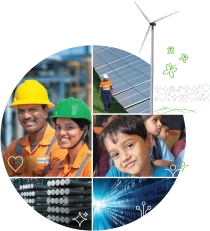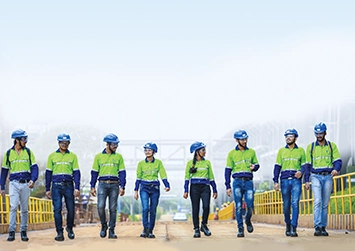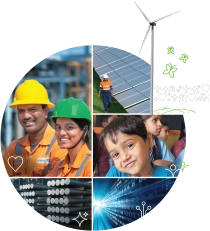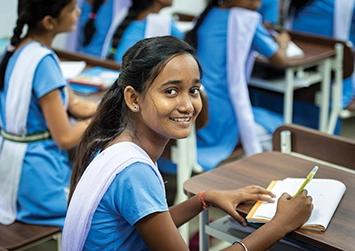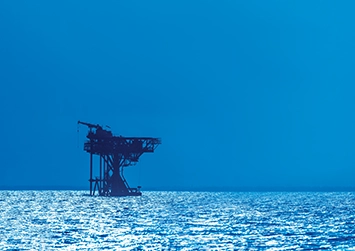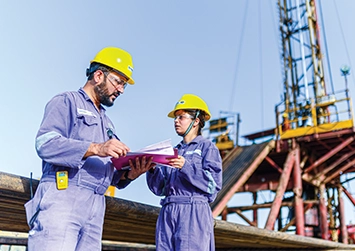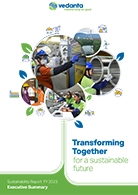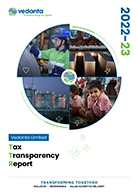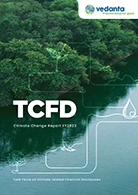OPERATIONAL REVIEW
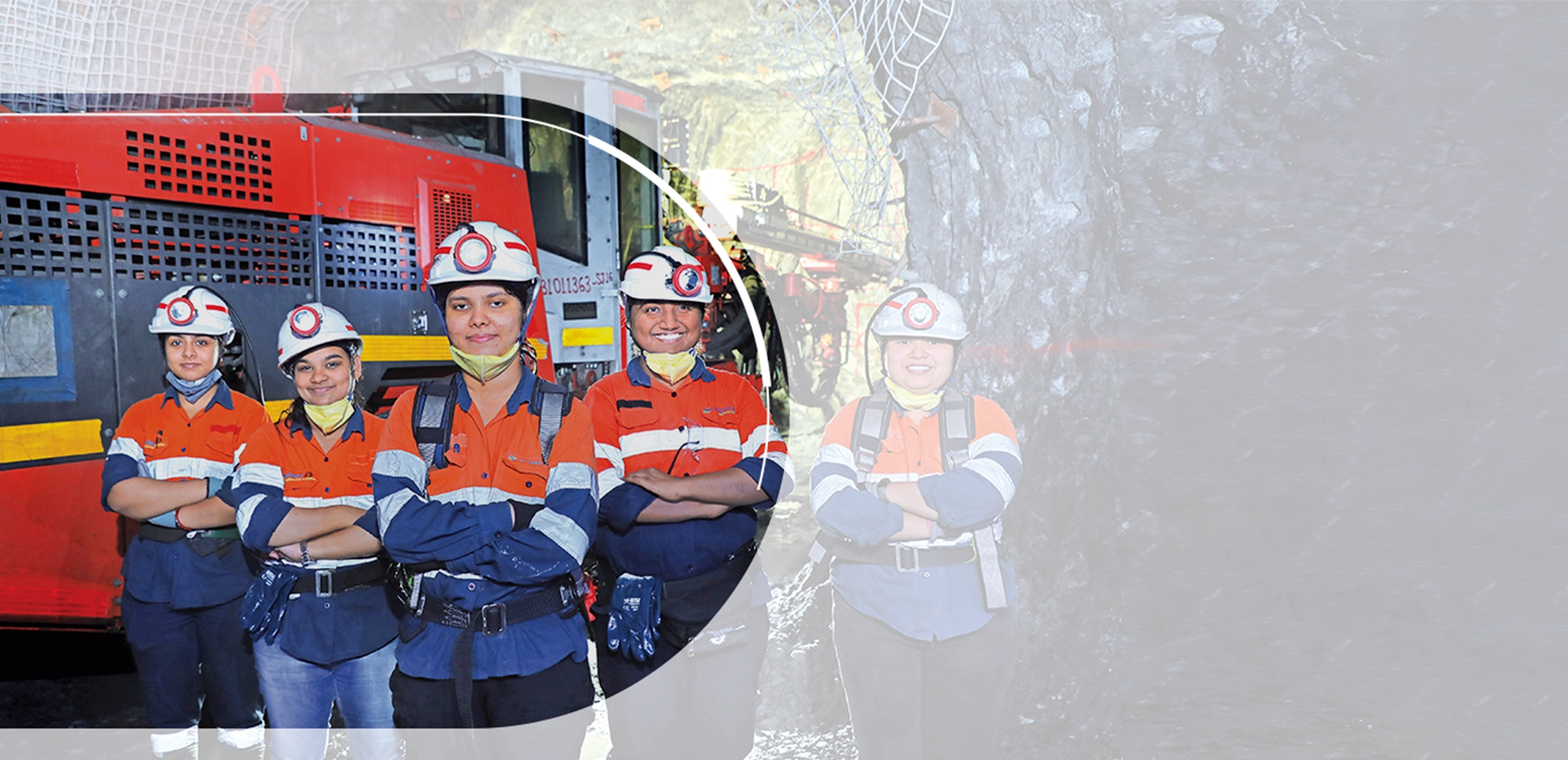
The year in brief
Mine production progressively improved during the year with ore production for the full-year up 2% YoY to deliver a record 16.74 million tonnes, supported by strong production growth at Rajpura Dariba Mine, SK Mines and Rampura Agucha mine, which were up 11%, 7% and 6% respectively. Mined metal production was up 4% YoY to 1,062 kt primarily on account of higher ore production improved mined metal grades and operational efficiencies.
1,032 kt
Highest ever refined Zinc-Lead production
714 tonnes
Ever-highest silver production
10% YOY16.74 million tonnes
Annual cost reduction
Europe's fight against the repercussions of war
In line with our commitment to ensure zero harm to employees, the leadership has undertaken the prime responsibility of providing a safe workplace for all employees entering our premises. While committed to operate a business with ‘Zero Harm’, it is with deep sadness that we report the loss of six business partners colleagues and one HZL employees in work-related incidents at our managed operations. These incidents happened despite our constant efforts to eliminate fatalities and attain a Zero Harm work environment. A thorough investigation was conducted to identify the causes of these incidents and to share the lessons learned across Hindustan Zinc, to prevent similar incidents in the future.
During the year, to avoid fatalities and catastrophic incidents in HZL, Vihan: A Critical Risk Management (CRM) initiative was launched to improve managerial control over rare but potentially catastrophic events by focussing on the critical controls. We have launched four critical risks i.e., Fall of Ground (FOG), Fall of person/object from height (WAH), Vehicle Pedestrian Interaction (VPI) and Entanglement. Through this initiative, we want to ensure that all identified critical controls are being monitored and systems are in place.
Safety Pause was also conducted across all our operational units under the theme 'Stop Work if it’s not Safe'. During this connect, all recent safety incidents happened across group companies were discussed and key learnings were shared.
Community of Practice - Structure Stability established during the year to establish a review mechanism of all prevailing civil and mechanical structures; further a specific categorisation was founded to mark the structures based on which their repair/replacement is planned.
Second half of the year has been an era of innovation for mining operations to avoid manual intervention and related risk with inclusion of: Single point remote blasting over wi-fi at pilot level, digitalised drilling of production stops during blasting operations in which no manpower is present and machine drills in auto mode with interlock features of approaching man, Digital RFID based cap lamps along with proximity sensors to ensure real-time tracking and monitoring of personnel working in underground and Digital interlockings have been developed to stop over winding operation during excess of mud/water at shaft bottom.
Training and capability building was also core theme during the year, few key programmes are first underground practical cum digitised training gallery developed at RAM to provide all facility of surface training to underground operations team, Wi-Fi Network available at training place so that underground manpower can connect from underground to any kind of seminars/trainings, safety leadership development program initiated for mines frontline supervisor through ex-DGMS officials and Dupont, RAM has also launched a unique virtual reality-based simulator training for jumbo operator.
Response during any emergency is a paramount parameter to ensure safety of the people. As a proactive measure, wehave conducted ERCP (Emergency Response and Crisis plan) Gap Assessment study across all the sites. 51st All India Mines Rescue Competition was hosted under the aegis of DGMS at Rajpura Dariba Complex, 10 days Capacity Building Training Programme on Disaster Management as conducted at ZM, the training included medical first responder, collapsed structure search & rescue, fire management, chemical emergencies, etc. RAM has reaffirmed safety & rescue by establishing Underground Fire Tender with remote operated foam unit and thermal imaging camera for blind zones.
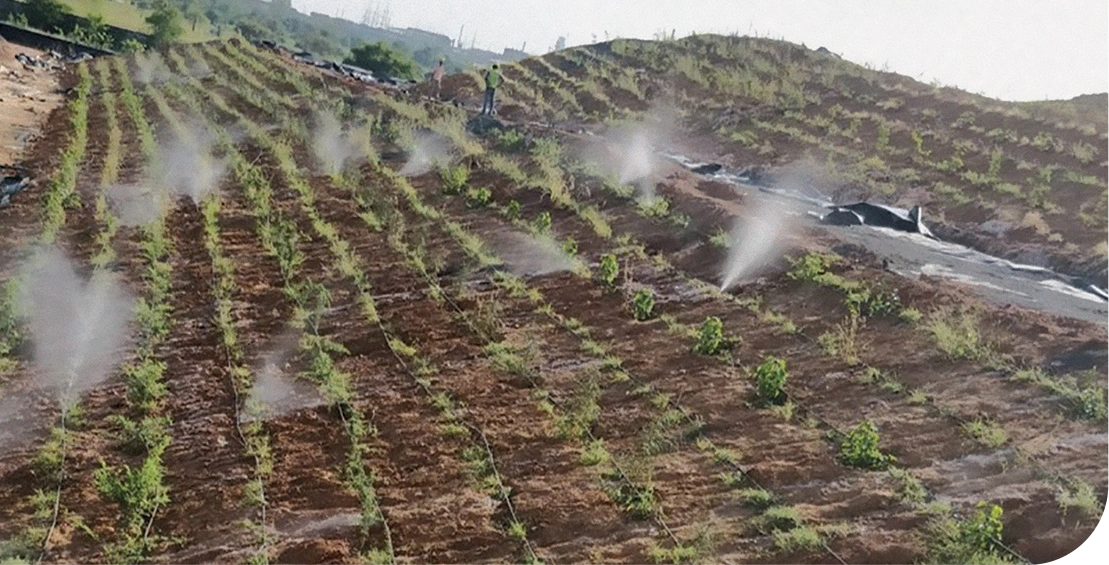
Demonstrating the highest standards of health and safety management during the year, Dariba Smelting Complex received the prestigious ‘Sword of Honour’ from British Safety Council for showing excellence in the management of health and safety risks at work. Kayad Mines received 5 Star Rating Award in Safety and Welfare by Rajasthan Government and Jaswant Singh Gill Memorial Industrial Safety Excellence Award 2022 in underground Metal mine in India.
Environment
Hindustan Zinc commits to ‘Long-term target to reach net-zero emissions by 2050’ in line with Science Based Targets initiative (SBTi) aiming to have a clear and defined path to reduce emissions in line with the Paris Agreement goals. To achieve the target, we are working towards improving our energy efficiency, switching to low carbon energy sourcing, introducing battery operated electrical vehicles and increasing the role of renewables in our energy mixes.
We have entered into a power delivery agreement for supplying 450 megawatts of renewable power by 2025 which will not only strengthen our commitment towards a clean future but also help reduce emissions to the tune of 2.7 million tCO2e. Also, Pantnagar metal plant is sourcing 100% green power for its operations thus making it a one-of-a-kind initiative, leading towards reducing emissions by 30,000 tCO2e.
Technology and digitalisation are key to strengthening our ESG footprint and creating a net-zero future. It is our ambition to convert all our mining equipment to battery-operated Electric Vehicles (EVs). To make our mining operations environment-friendly, we plan to invest US$1 billion over the next five years towards combating climate change impacts.
Electric Vehicles (EVs) are a globally recognised means to alleviate dependence on petroleum products and reduce CO2 emissions. Therefore, Hindustan Zinc signed a Memorandum of Understanding (MoU) with Epiroc Rock Drills AB, Normet Group Oy and Sandvik AB to introduce battery electric vehicles (BEV) in its underground mining operations making Hindustan Zinc the first company in India to introduce battery-operated vehicles in underground mines.
HZL has led by example by inducting LNG-powered truck for transportation which shall contribute 30% lesser towards GHG emission. We are also using 5% biomass for power generation and reducing carbon footprint through our captive thermal power plants.
In-line with HZL’s policy of a green value chain, our business partners have also started operating Electric vehicles, several electric forklifts have been introduced in our multiple business units.
At HZL, we recognise the reality of climate change. Therefore, our risk management processes embed climate change in the understanding, identification, and mitigation of risk. We have published our second TCFD (Task Force on Climate-related Financial Disclosure) report during the year which sets the adoption of the TCFD framework for climate change risk and opportunity disclosure.
Endeavouring towards sustainable organisation, we have relooked our materiality matrix and established the ESG governance at tier 3 level as well as at SBU level to implement ESG projects on ground.
Hindustan Zinc joins the Taskforce on Nature-Related Financial Disclosures (TNFD) piloting with ICMM to access the challenges in implementing LEAP process of TNFD.
Miyawaki afforestation was completed at DSC and CLZS. 12,000 Indigenous Plants and 6,500 native seeds planted in the area of 1 hectare at each of the location to create a self-sustaining forest in the span of 3 years. 3 years Engagement with IUCN has initiated, under this Prepared IBAT (Integrated Biodiversity Assessment Tool) Report for all Rajasthan-based locations identifying species present in the core area, Reframed Biodiversity Policy of HZL, Ecosystem Service review conducted across the Rajasthan based locations and Biodiversity risk assessment and site visit by IUCN team members for one season completed. These studies will help HZL to prepare a strategy to achieve ‘No Net Loss’ towards biodiversity. Green cover study done by SRSAC (State Remote Sensing Application Centre, Jodhpur) for all Rajasthan-based locations of HZL.
One of the most notable achievements has been the successful commissioning of a 3,200 KLD Zero Liquid discharge (RO-ZLD) plant at the Dariba Smelter. Apart from that, Zawar (ZM) and Rampura Agucha Mine ZLD projects of 4,000 KLD capacity each have been initiated to improve recycling and strengthen the zero discharge. Like ZM, dry tailing plant at Rajpura Dariba Mine is also under final stage of commissioning and will result in significant amount of water recovery from the tailings.
Site Inspection and updated GISTM (Global Industry Standard on Tailing Management) Conformance Assessment completed by ATC Williams for all TSF (Tailing Storage Facility). Environment Product Declaration (a Type 3 Ecolabel) for zinc product published.
Public hearing was conducted successfully at CLZS for proposed enhancement of zinc production capacity from 504 to 630 kt and installation of Induction Furnace, Slab Casting Line, RZO Unit, change in product mix in Pyro unit on total metal basis & installation of lead refinery & minor metal complex etc.
Production performance
Operations
For the full-year, ore production was up 2% YoY to 16.74 million tonnes on account of strong production growth at Rajpura Dariba Mine, SK Mines and Rampura Agucha Mine, which were up 11%, 7% and 6% respectively. FY 2023 saw the best-ever Mined metal production of 10,62,089 tonnes compared to 10,17,058 tonnes in the prior year in line with higher ore production across Mines supported by better metal grades and operational efficiencies.
For the full year, we saw our ever-highest metal production, up 7% to 1,032 kt in line with better plant and MIC availability, while silver production was 10% higher at 714 million tonnes in line with higher lead metal production.
FY 2023 started well with the prices around ~US$4,000/t. With the impact of the Russia-Ukraine War, lockdown announced in China and US GDP contraction, zinc prices hovered around US$4,400/t for most of April 2022 and ended at US$4,100/t. In the month of May, prices went down to US$3,499/t over concerns of economic slowdown in the US and China. Prices again rebounded above US$4,000/t driven by increased expectation of a stimulus from the Chinese government to support growth in order to offset the impact of the coronavirus. However, in Q3 FY 2023, negative sentiment of the market pushed down the LME prices in October 2022 and reached to US$2,682/t on 3 November 2022, lowest since February 2021. With the sudden end to China’s zero-Covid policy at the end of CY 2022 and the prospect of Chinese demand rebound, the faith in base metals has been restored in investors. This gave the muchneeded boost and prices rose above US$3,400/t in January 2023, with monthly average of US$3,289/t. However, the trend has not lasted for long and prices have corrected to US$2,956/t in March 2023.
In long term, the prices will be pressured by growing surpluses. The higher zinc prices in recent years have encouraged the development of a significant amount of new mine projects. However, the smelter capacity suggests not all of this new mined output will be processed, leading to concentrate surpluses. At the same time, smelter output growth is forecast to outpace demand growth. This, in turn, will lead to a significant refined stock build. As the cumulative surplus becomes unsustainably large, prices will fall lower to rebalance the market.
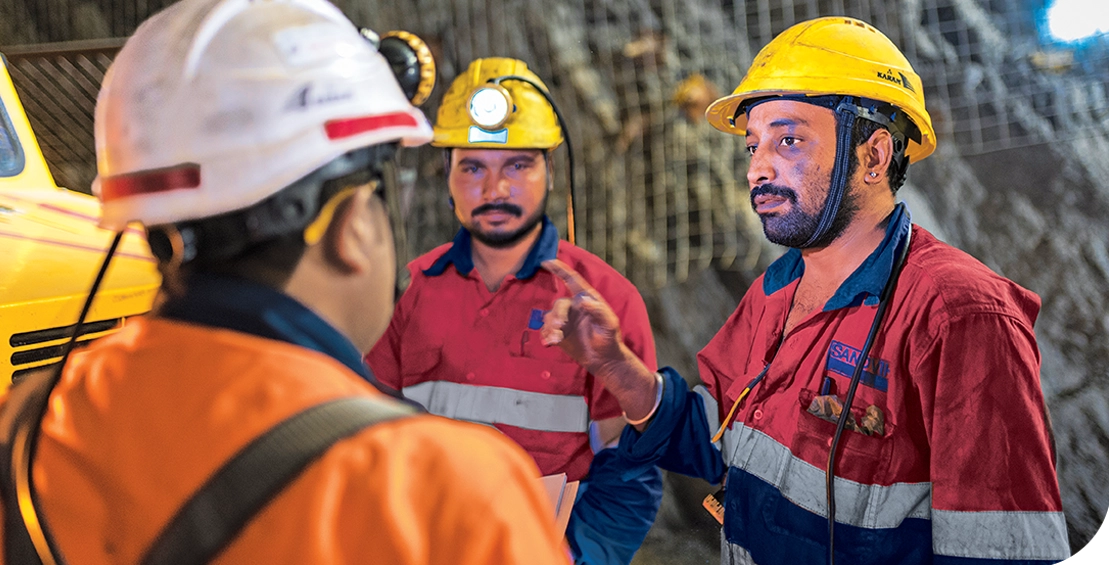
Zinc Demand-Supply
Source: Wood Mackenzie, March STO
Global demand witnessed contraction in CY 2022, decreasing by 3.0% to 13.6 million tonnes, largely due to the fall in Chinese demand. At supply level, the refined zinc metal production fell by 2.6%, as several smelters closed for care and maintenance across the world owning to the increase in energy prices. The global mined zinc production is expected to grow stronger during 2023 to 2026 period as there will be new mine projects ramping-up. And it is expected that the production will grow by 1.8% to 13.8 million tonnes in 2023,.
The global zinc warehouse stocks also fell during this period due to supply constraints. The total tonnage of zinc in the Shanghai Futures Exchange (SHFE) warehouses fell to 20 kt at the end of December 2022 and settled at 97 kt at the end of March 2023, from 176 kt in April 2022. And the London Metal Exchange (LME) stocks stood at 45 kt at the end of the March 2023, down from 140 kt in April 2022.
The Indian economic environment has remained optimistic. The same was reflected by the S&P Global Manufacturing PMI which stood at 56.4 in March 2023 as compared to 54.7 in April 2022 and 55.3 in February 2023, reflecting expansion in manufacturing sector. The Indian automobile industry is on a growth trajectory, with 13.5% increase in production to reach 227 lakh units till February 2023 from April 2022, compared to the same period in the previous fiscal. The passenger vehicle sales stood at 29 lakh units, marking a growth of 30% over the same period in the previous year.
(Source: SIAM & SP Global Index)
The finished steel domestic production was at 110.44 million tonnes during April 2022 to February 2023, up by 7.2% over the same period in the previous year. Consumption in domestic market during the same period stood at 108.15 million tonnes, up by 12.6%. The total net finished steel exports till February 2023 stood at 5.90 million tonnes, down by 52% over same period in the previous financial year on account of export duty levy.
(Source: MIS Report on Iron & Steel by JPC)
The overall domestic demand for primary zinc in this financial year has seen growth rate of 3.8% compared to last year, reaching pre COVID levels, and it is expected to grow further by 4% in FY 2024.
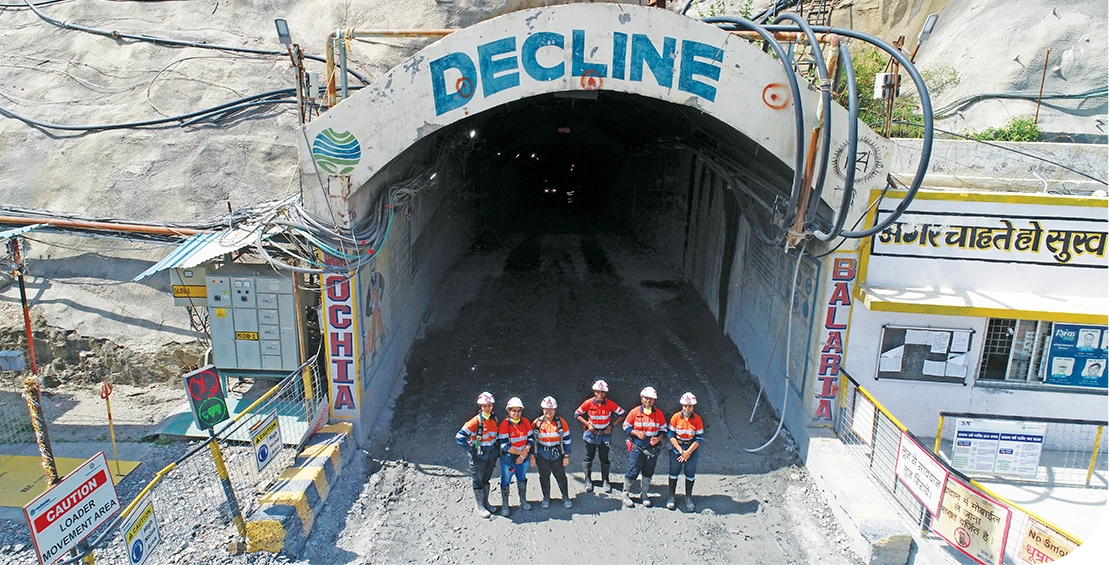
Unit costs
For the full year, zinc COP excluding royalty was US$1,257/t, higher by 12% YoY (21% higher in ₹ terms). The COP has been affected by higher coal & commodity price increase partially offset by benefits from better volumes, operational efficiencies & recoveries.
Financial performance
Revenue from operations for the year was ₹33,120 crore, up 16% YoY, primarily on account of higher metal & silver production, higher Zinc LME prices, gains from strategic hedging and favourable exchange rates partially offset by lower lead and silver prices.
EBITDA in FY 2023 increased to ₹17,474 crore, up 8% YoY. The increase was primarily driven by improved metal and silver volumes, higher Zinc LME prices, gains from strategic hedging and favourable exchange rates partly offset by higher costs and lower lead & silver prices.
Projects
In HZL journey of 1.25 MTPA MIC expansion, only left-out project of RD Beneficiation plant revamping is under execution at RD Mines which is scheduled to be commissioned in Q1 FY 2024. Fumer plant final commissioning delayed due to VISA issues of OEM from China. The plan is to complete commissioning of plant through OEM support in Q1 FY 2024. For further phase of expansion of Mines and Smelters, studies are under progress and results are expected in FY 2024.
The capacity of smelters is being enhanced by putting up a new Roaster in Debari with latest technologies. The order placement is targeted by Q1 FY 2024.
A new project of Hindustan Zinc Alloys ordered in Q1 FY 2023 is under execution and scheduled for completion in Q1 FY 2024. HZL is also setting up new Fertiliser Plant in Chanderiya for which partner has been locked in. Formal order placement is scheduled to be completed in Q1 FY 2024. Project is scheduled for completion in 24 months.
Exploration
Zinc India’s exploration objective is to upgrade the resources to reserves and replenish every tonne of mined metal to sustain more than 25 years of metal production by fostering innovation and using new technologies. The Company has an aggressive exploration program focussing on delineating and upgrading Reserves and Resources (R&R) within its licence areas. Technology adoption and innovations play key role in enhancing exploration success.
The deposits are ‘open’ in depth, and exploration has identified number of new targets on mining leases having potential to increase R&R over the next 12 months. Across all the sites, the Company increased its surface drilling to assist in Resource addition and upgrading Resources to Reserves.
In line with previous years, the Mineral Resource is reported on an exclusive basis to the Ore Reserve and all statements have been independently audited by SRK (UK).
On an exclusive basis, total ore reserves at the end of FY 2023 totalled 173.49 million tonnes and exclusive mineral resources totalled 286.56 million tonnes. Total contained metal in Ore Reserves is 9.64 million tonnes of zinc, 2.7 million tonnes of lead and 310.2 million ounces of silver and the Mineral Resource contains 12.8 million tonnes of zinc, 5.66 million tonnes of lead and 545.7 million ounces of silver. At current mining rates, the R&R underpins metal production for more than 25 years.
Strategic Priorities & Outlook
Our primary focus remains on enhancing overall output, cost efficiency of our operations, disciplined capital expenditure and sustainable operations. Whilst the current economic environment remains uncertain, our goals over the medium term are unchanged.
Our key strategic priorities include:
- Further ramp-up of underground mines towards their design capacity, deliver increased silver output in line with communicated strategy
- Sustain cost of production to be in the range of US$1,125-US$1,175 per tonne through efficient ore hauling, higher volume & grades and higher productivity through ongoing efforts in automation and digitisation
- Disciplined capital investments in minor metal recovery to enhance profitability
- Increase R&R through higher exploration activity and new mining tenements, as well as upgrade resource to reserve
- Progressing towards sustainable future with continued efforts towards reduction in GHG emissions, water stewardship, circular economy, biodiversity conservation and waste management
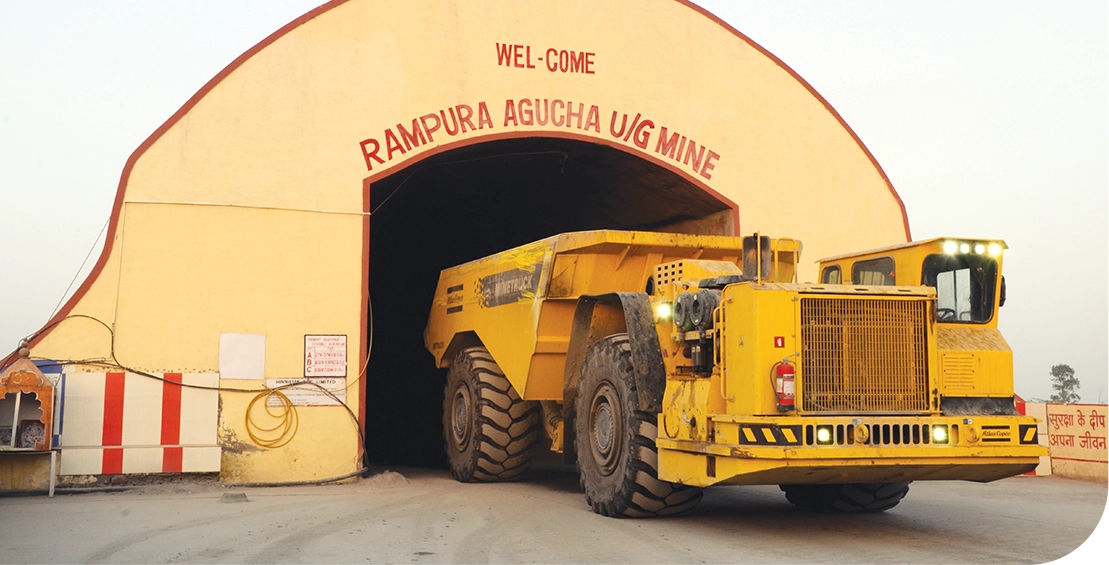
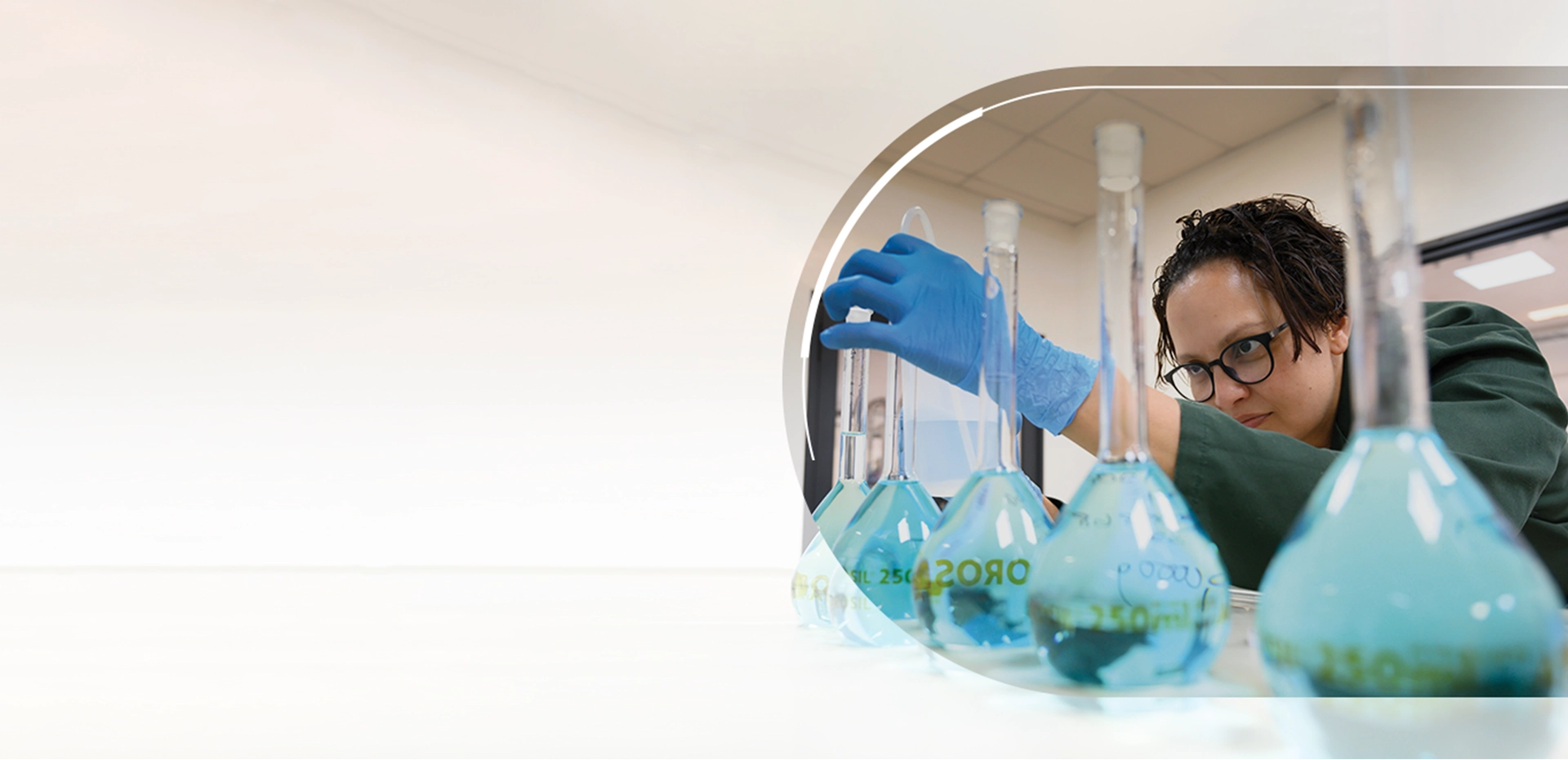
The year in brief
During FY 2023, Zinc International continued to ramp-up production at Gamsberg mine and achieved record production of 208 kt. This was mainly due to increase in tonnes treated and plant recoveries compared to previous financial year.
Black Mountain continued to have a improved production of 65 kt, which is significantly higher than FY 2022 due to higher lead grades and recoveries.
Skorpion Zinc has been under Care and Maintenance since start of May 2020, following cessation of mining activities due to geotechnical instabilities in the open pit. Activities to restart the mine are still in progress.
208 kt
Record mined metal production at Gamsberg
Occupational health & safety
At Vedanta Zinc International (VZI), we take the health and safety of our employees and stakeholders very seriously and we remain committed to communicating timeously and transparently to all stakeholders.
Airborne particulate management remains a key focus in reducing lead and silica dust exposures of employees (Exposure Reduction to Carcinogenic). VZI had 17 blood lead withdrawals for FY 2023, against more stringent limits than required by law. We have strengthened our Employee Wellness Programme, focussing on the increased participation of employees and communities in VCT for Aids/HIV, blood donation and wellness.
VZI is embarking on a real-time monitoring strategy and additional controls at source to reduce and eliminate exposures to both silica and lead.
The VZI LTIFR improved from 1.41 in FY 2022 to 0.75 in FY 2023. The TRIFR improved from 5.6 in FY 2022 to 3.1 in FY 2023, both improving by 46% and 44% respectively. VZI remained fatal free during FY 2023, and Black Mountain Mine achieved LTI free year. These remarkable achievements were necessitated by VZI’s strong commitment to Zero harm principle and a belief that everybody coming to VZI must return home safe and healthy every day.
Leading Indicators reporting, Leadership Engagements and Critical Risk Management were the strategic initiatives central to these record setting achievements. VZI shall, in collaboration with the Mineral Council and Vedanta Group continue to seek for leading practices to continually improve our HSE performance.
Environment
VZI has secured Portion 1 of the farm Wortel 42 as the fifth Biodiversity Offset Property and has presented the property to the Department of Agriculture, Environmental Affairs, Rural Development and Land Reform (DAERDLR). Once the property is transferred to BMM’s name, there will be declaration of this property as a Protected Area, as an inclusion to the Gamsberg Nature Reserve Protected Area under the National Environmental Management Protected Areas Act, 2003 (Act No. 57 of 2003). This is a requirement of Clause of the Biodiversity Offset Agreement (BOA). BMM is in negotiations with landowners to secure the remaining two farms by 1 April 2024 to ensure compliance to Clause 6 of the BOA.
The Second Independent Audit on the Implementation of the BOA between BMM and DAERDLR commenced October 2022 and the draft reports have been submitted to the implementation parties (BMM and DAERDLR) for comments and review. The final report will be available by end of March 2023 with a large improvement since the previous audit. The final report will be published in VZI Annual Report and on the VZI webpage as required by the BOA.
The implementation of the nine Biodiversity Monitoring Protocols has been completed for a test year and will be revised and updated in April 2023 for long-term implementation. BMM are awaiting verification of the status of No Net Loss that was monitored and measured as part of the implementation of the Biodiversity Monitoring Protocols and a statement regarding the findings and verification will be shared.
The installation of a dedicated anti-poaching surveillance camera network, covering a circular route of more than 400 km show good results and according to statistics received from South Africa Police Services (SAPS) and the Agri Namakwaland the surveillance camera network has resulted in a large decrease in petty crime in the area. However, incidents of poaching outside the surveillance cameras are still reported on an ad hoc basis as poachers adjust their modus operandi. An Antipoaching workshop between IUCN, BMM, DAERDLR, South Africa Biodiversity Institute (SANBI), SAPS and key role players in the area are planned for April 2023.
Production performance
Operations
During FY 2023, total production stood at 2,72,713 tonnes, 22% higher YoY. This was primarily due to tonnes treated and higher recoveries.
At BMM, production was 65,112 tonnes, 25% higher YoY. This was mainly due to 8.9% higher throughput at 1.7 million tonnes, higher lead grades (3.0% vs 2.1%) and recoveries (82.8% vs 81.6%) offset by lower grades of zinc (1.8% vs 2.1%) and recoveries (71.9% vs 75.2%).
Gamsberg’s production was at 2,07,601 tonnes as the operation continues to ramp up with improved performance during current financial year. Higher production at Gamsberg YoY is attributable to 7.8% increase in throughput to 4.2 million tonnes, higher zinc grades (6.5% vs 6.2%) and recoveries (75.7% vs 69.9%).
At Skorpion Zinc engagement with technical experts to explore opportunities of safely extracting the remaining ore is ongoing. The pit optimisation work is complete. The business is currently evaluating options to restart mining.
Unit costs
Gamsberg COP excluding TcRc decreased by 12% to US$1,033 per tonne. This reflects the strength and efficiency of our operations at Zinc International. The decrease in the cost of production was driven by higher production supported by local currency depreciation against the US$ despite high input commodity inflation.
Overall Zinc COP including TcRc increased by 9% to US$1,577 per tonne, from US$1,442 per tonne in the previous year. This was mainly driven by commodity price inflation and higher treatment and refining charges, offset by higher production and local currency depreciation against the US$.
Financial performance
During the year, revenue increased by 16% to ₹5,209 crore, driven by higher sales volumes compared to FY 2022 due to 22% higher production BMM & Gamsberg, higher zinc LME prices and favourable exchange rates movement partially offset by lower lead and silver prices.
EBITDA increased by 26% to ₹1,934 crore, from ₹1,533 crore in FY 2022 also mainly on account of improved operational performance, higher zinc LME price, favourable exchange rates movement partially offset by lower lead & silver prices and increase in TC/RC.
Projects
Refinery Conversion – The Skorpion Refinery Conversion project has reached Ready-to-order phase, post completion of FEED, feasibility study, tendering activities & techno-commercial adjudication and contract finalisation. All regulatory approval is in place to start project execution.
With power tariffs being very critical for the viability of the project, discussions/negotiations are in progress with the state power utility along with the option of renewable power which is also being explored. We are only waiting for confirmation of power tariff to take the final decision and starting the execution on the ground by H1 FY 2024.
Gamsberg Phase 2 – Gamsberg Phase 2 project includes the mining expansion from 4 MTPA to 8 MTPA and Construction of New Concentrator plant of 4 MTPA, taking the total capacity to 8 MTPA and was approved by the Vedanta Board in Q4 of FY 2022. The EPC partner, Onshore, has been appointed in Q1 FY 2023, site mobilisation completed, detailed engineering is under progress and the project is in execution phase. All Major Long lead FIMs {Ball & Sag Mill (CITIC), Crusher, Floatation, Filter Presses and Thickeners Package (MO)} Orders placed.
Cumulative progress – Engineering – 61.79%; Procurement – 35.17%; Construction - 1.57%; Overall project – 16.26%
Transformer and 11 KV Switchgear partner are locked in
Crusher House & LV Substation Foundation Works-in-Progress
Wet TSF Design under progress – Geo Chemical investigation completed. Geotech investigation in progress
External Power & Water package –Site established, and work started
Workmen Camp & Site Office Establishment – In progress
Gamsberg Smelter – The Gamsberg Smelter Project is re‑defined with phased approach wherein 210 KTPA capacity phase 1 will be executed by repeating the available HZL smelter design incorporating necessary modifications required to treat Gamsberg Concentrate. The partner selection is in progress for various EPC/EP+C packages. We have appointed ThyssenKrupp (TKIS-India) as Owner’s engineer. The techno‑commercial proposals with Shapoorji & L&T as the prospective EP Partners. Construction Tender released on 23 November 2022.
RFQs for all FIMs released
Construction Tender released on 23 November 2022. Offers are received and are under Commercial negotiations
The techno-commercial proposal for EPC 1 (on EP basis) is received from Shapoorji and it is under commercial adjudication. L&T ‘s offer is awaited
Pre bid meeting conducted with all prospective partners for Renewable Power. Proposals received from 4 vendors
We have received the environmental approval for the Smelter & Bulk water pipeline construction. The Smelter EC is currently under appeal phase. We are also engaging with Gov. of South Africa on the other critical success factors like SEZ, power price, sulphuric acid offtake, logistics infrastructure and balance regulatory approvals which are vital for economic feasibility of the project.
Black Mountain Iron Ore project – This is a project to recover iron ore (magnetite) from the BMM fresh tailings. EPC’s detailed engineering, procurement, earthworks, and major fabrication are completed. Construction is currently at 76.4% completion. Project being relooked for repurposing under guidance of CEO, Zinc Business.
Exploration
0.3% increase in resources from 27.20 million tonnes to 27.29 million tonnes metal and 4.4% reduction in reserve metal tonnes from 7.9 million tonnes to 7.6 million tonnes.
Total R&R for VZI decreased from 671 million tonnes to 659 million tonnes of ore, while metal decreased from 35.1 million tonnes to 34.87 million tonnes (0.7% decrease in total metal)
Reduction in reserves largely attributable mining depletions and the slight increase in resources due to addition of metal tonnes at Kloof which was offset by an increase in transport/operating costs and increased dilution which impacted the cut-offs used.
Strategic Priorities & Outlook
Zinc International continues to remain focussed to improve its YoY Production by sweating its current assets beyond its design capacity, debottlenecking the existing capacity, and adding capacity through Growth Projects. Our Immediate priority is to ramp up the performance of our Gamsberg Plant at designed capacity and simultaneously complete Gamsberg Phase 2 project to add another 190 kt to the total production of VZI. Likewise, BMM continues to deliver stable production performance and focus is to debottleneck its ore volumes from 1.8 million tonnes to 2.0 million tonnes. Skorpion is expected to remain in Care and Maintenance, while management is assessing feasible & safe mining methods to extract ore from Pit 112. Zinc International continues to drive cost reduction programme to place Gamsberg operations on 1st Quartile of global cost curve with COP< US$1,100 per tonne.
Core Growth strategic priorities include the following:
- Completion of construction activities of Gamsberg Phase 2 project with the aim to start production in H2 FY 2024
- Continue to improvise Business case of Skorpion Refinery Conversion Project and Gamsberg Smelter Project through Government support, Capex and Opex reduction
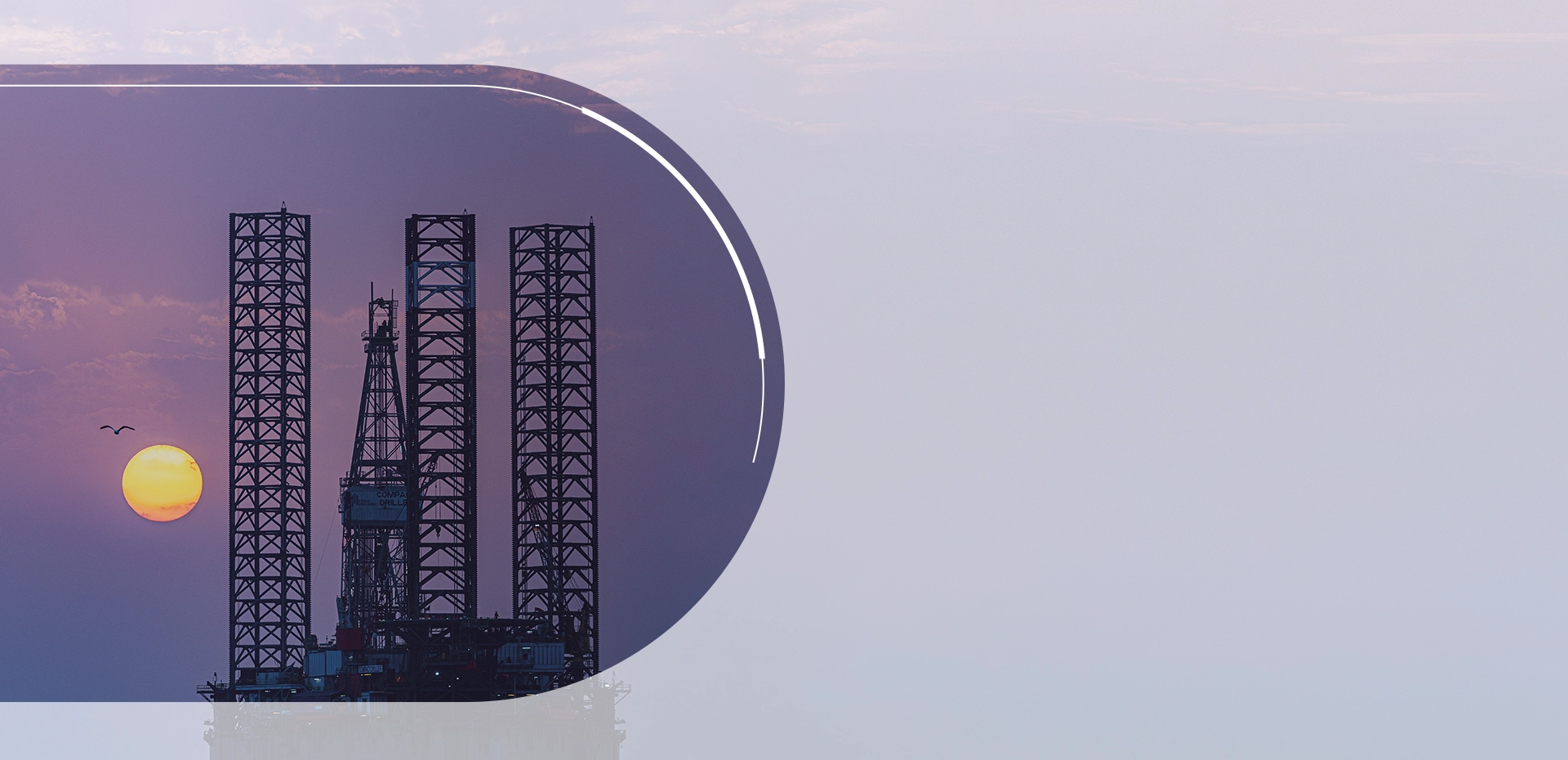
The year in brief
During FY 2023, Oil & Gas business delivered gross operated production of 143 kboepd, down by 11% YoY, primarily driven by natural reservoir decline at the MBA fields. The decline was partially offset by addition of volumes through new infill wells brought online in Mangala, Bhagyam and Raageshwari Deep Gas fields. Offshore assets were supported by gains from the infill drilling campaign across both assets Ravva and Cambay.
In OALP blocks, we have secured 8 blocks in DSF-III round and one Coal Bed Methane (CBM) Block in special CBM round 2021.
143 kboepd
Average gross operated production
10% YOYOccupational Health & Safety
There was one lost time injuries (LTIs) in FY 2023. Frequency rate stood at 0.03 per million-man hours (FY 2022: 0.20 per million-man hours).
Our focus remains on strengthening our safety philosophy and management systems.
Cairn Oil & Gas has taken various initiatives:
“5S” certification for Mangala, Raageshwari and Aishwarya Mines.
Established Mines Vocational Training Centre at RJ Oil, Barmer.
Project CSUSP (Cairn Sustainability & Safety Performance Program), a journey to improved sustainable and increased safety performance initiated.
Digital initiatives: NLP (Natural Language Processing) based Safety Observation Reader, Training through Virtual Reality Headsets, QR code based tracking system for fire cylinders.
Artificial intelligence-based safety surveillance system installed across locations.
COVID-19 mass booster dose vaccination drive for employees, their family members and business partners.
Environment
Our Oil & Gas business is committed to protect the environment, minimise resource consumption and drive towards our goal of ‘zero harm, zero waste, zero discharge’. Highlights for FY 2023 are as:
- Cairn Oil & Gas declared as Water Positive Company with NPWI (Net water positive impact) index of 1.12. Four of our sites RJ Oil, RJ Gas, Midstream and Ravva) are also individually declared as water positive assets.
Biodiversity/wildlife conservation initiatives
MoU signed with District Forest Office, Rajasthan and Gujarat for plantation of 0.35 million trees over 700 hectares in Barmer district and development of 60-hectare mangroves forest in Sural Coastal area respectively.
Biodiversity assessment completed with objective to draw No Net Loss or Net Positive Impact.
Drinking water facility developed for wild animals at Dhorimanna Hilly Forest Area, Barmer.
Revival of Khejari in Thar Ecosystem through Agro forestry and distributed 300 saplings to community farmers.
Published book “Know Your Flora – A Glimpse of Thar Ecosystem” and video on "Ravva Biodiversity - Photo Journey of a Nurtured Ecosystem”.
Reduction in GHG emission:
Cairn signed Power Purchase Agreement (PPA) for 25 MW renewable energy
Installation of 150+ Solar lights at Mangala Processing Terminal & well pads for renewable power generation ~32,000 units/annum. Drinking water facility developed for wild animals at Dhorimanna Hilly Forest Area, Barmer.
Reduction in RDG flare by tuning the control valve of condensate flash drum (CFD) & Stabiliser column & recycle gas compressor optimisation with annual GHG Reduction potential of 17,300 tonnes of CO2e/annum.
Solar rooftop installed on 10 AGIs (above ground installations) for pipeline operations (Annual GHG reduction potential of 208 tonnes of CO2 e/annum)
Installation of 220 KWP of Solar Rooftop at RJ Gas and 130 KWP at Radhanpur Terminal (Annual GHG reduction potential of ~440 tonnes of CO2e/annum).
Commissioned 10 KWP Solar Plant at Cambay asset.
Introduced 5 new Electric Golf carts at RJ Gas for internal commuting.
All Operating assets of Cairn (RJ Oil, RJ Gas, Midstream operations, Ravva, and Suvali) have been certified as “Single Use Plastic free” premises.
Production performance
Operations
Average gross operated production across our assets was 11% lower YoY at 1,42,615 boepd. The Company's production from the Rajasthan block was 1,19,888 boepd, 13% lower YoY and from the offshore assets, was at 22,579 boepd, 2% lower YoY, owing to natural field decline. The decline has been partially offset by infill wells brough online across all assets.
Production details by block are summarised below:
Rajasthan block
Gross production from the Rajasthan block averaged 1,19,888 boepd, 13% lower YoY. The natural decline in the MBA fields has been partially offset by infill wells brought online in Mangala, Bhagyam, ABH and RDG fields.
Gas production from Raageshwari Deep Gas (RDG) averaged 142 million standard cubic feet per day (mmscfd) in FY 2023, with gas sales, post captive consumption, at 118 mmscfd.
On 26 October 2018, the Government of India, acting through the Directorate General of Hydrocarbons (DGH), Ministry of Petroleum and Natural Gas, granted its approval for a ten-year extension of the PSC for the Rajasthan block, RJ-ON-90/1, subject to certain conditions, with effect from 15 May 2020. The Division Bench of the Delhi High Court in March 2021 set aside the single judge order of May 2018 which allowed extension of PSC on same terms and conditions. We have filed a Special Leave Petition (SLP) in Supreme Court against this Delhi High court judgement.
We have served notice of Arbitration on the GoI in respect of the audit demand raised by DGH based on PSC provisions. The final hearing and arguments were concluded in September 2022. Post hearing briefs have been filed by the parties on 11 November 2022. It is our position that there is no liability arising under the PSC owing to these purported audited exceptions. The audit exceptions do not constitute demand and hence shall beresolved as per the PSC provisions.
Pursuant to GoI's approval for extension vide letter dated 26 October 2018, the parties have now executed the addendum for PSC extension for 10 years from 15 May 2020 to 14 May 2030 on 27 October 2022.
Ravva block
The Ravva block produced at an average rate of 11,802 boepd, lower by 17% YoY, owing to natural field decline.
Cambay block
The Cambay block produced at an average rate of 10,777 boepd, higher by 21% YoY, supported by gains from the infill well drilling campaign.
Prices
Crude oil price averaged US$96.2 per barrel in FY 2023, compared to US$81.15 per barrel in FY 2022. The continuous upward movement is mostly driven by supply constraints following Russia’s invasion of Ukraine.
Early in the year, prices rose amid tight supply after a build in U.S. crude and gasoline stocks, limited spare capacity of OPEC and downfall in supply from Caspian Pipeline Consortium. Demand outlook remains clouded by increasing worries about an economic slump in the United States and Europe, debt distress in emerging market economies.
Further, faltering economic backdrop and weakening outlook for consumption caused a volatility in the oil prices. Interest rate hike by central banks around the world weighted on demand outlook and series of rate hikes by US Fed caused dollar to spiral to two decades high to make oil more expensive to the buyers holding currency other than dollar. COVID-19 restrictions in China and US administration releasing oil inventories from strategic reserve further eased the prices.
However, in March, financial markets witnessed uncertainty, triggered by the turmoil in the US and European banking sector. Concerns about potential financial contagion effects and the risk that banking sector turmoil will extend to the economy pushed crude oil prices sharply down to 15-month lows at US$75/bbl.
In April, decision by OPEC and allies to slash May production by 5,00,000 bopd in a bid to arrest the slump in prices provided floor to the prices.
Financial performance
Revenue for FY 2023 was 21% higher YoY at ₹15,038 crore (after profit petroleum and royalty sharing with the Government of India), as a result of the increase in oil prices, favourable exchange rate movements partially offset by lower sales volume. EBITDA for FY 2023 was at ₹7,781 crore, higher by 30% YoY as a result of higher brent prices, favourable exchange rate movement, increase in capex recovery partially offset by lower volumes and increased cost.
The Rajasthan operating cost was US$14.2 per barrel in FY 2023 compared to US$10.1 per barrel in FY 2022, primarily driven by increase in polymer commodity index, owing to oil price rally and increased well interventions to manage natural field decline.
A. Growth Projects Development
The Oil & Gas business has a robust portfolio of infill development & enhanced oil recovery projects to add volumes in the near term and manage natural field decline. Some of key projects are:
Infill Projects
Bhagyam
To accelerate production and augment reserves from Bhagyam field, infill drilling opportunities in FB1 and FB3 layers were identified. The project entails drilling of 11 infill producers and injector wells in FB3 layers and three horizontal wells in the bio-degraded zone.
As of 31 March 2023, 12 wells have been drilled, of which 7 wells are online.
Aishwarya
Based on the success of the polymer injection in Lower Fatehgarh (LF) sands of Aishwariya field, additional production opportunities were identified in Upper Fatehgarh (UF) sands. The project entails drilling of 25 infill wells in Upper Fatehgarh (UF) sands and conversion of 7 existing wells to UF polymer injectors.
As of 31 March 2023, 18 wells have been drilled, of which 8 wells are online.
Tight Oil (ABH)
Aishwariya Barmer hill infill drilling program established confidence in reservoir understanding of ABH. Based on its success, drilling of 14 additional wells were conceptualised.
Early acceleration of three wells has been completed during the fiscal year 2023. Drilling is to re-commence from first quarter of fiscal year 2024.
Tight Gas (RDG)
In order to realise the full potential of the gas reservoir,an infill drilling campaign of 27 wells has commenced during fiscal year 2022. As of 31 March 2023, 24 wells have been drilled of which 17 wells are online.
Satellite Fields
In order to monetise the satellite fields, 14 wells development campaign for 3 satellite fields (GSV, Tukaram, Raag Oil) was conceptualised. Drilling has been completed during fiscal year 2023 and they are being progressively hooked up to ramp up volumes.
Cambay (Offshore)
Infill program in Cambay over the last few years has resulted in incremental recovery. New opportunities had been identified basis integration of advanced seismic characterisation, well and production data. Project has been completed during the second quarter of fiscal year 2023 and two wells are online.
Ravva (Offshore)
To augment reserve base and manage natural decline, infill opportunities were identified in Ravva asset. The project entails drilling of four exploration wells and 1 development well.
Project has been completed during the fourth quarter of fiscal year 2023 and success has been notified in two exploration wells and 1 development well which are online and producing. No hydrocarbons were observed in two wells and have been declared dry.
Discovered Small Field (DSF)
Hazarigaon: Well intervention and testing activities was carried out in Hazarigaon-1 well and monetisation is underway. Production commenced from third quarter of fiscal year 2023.
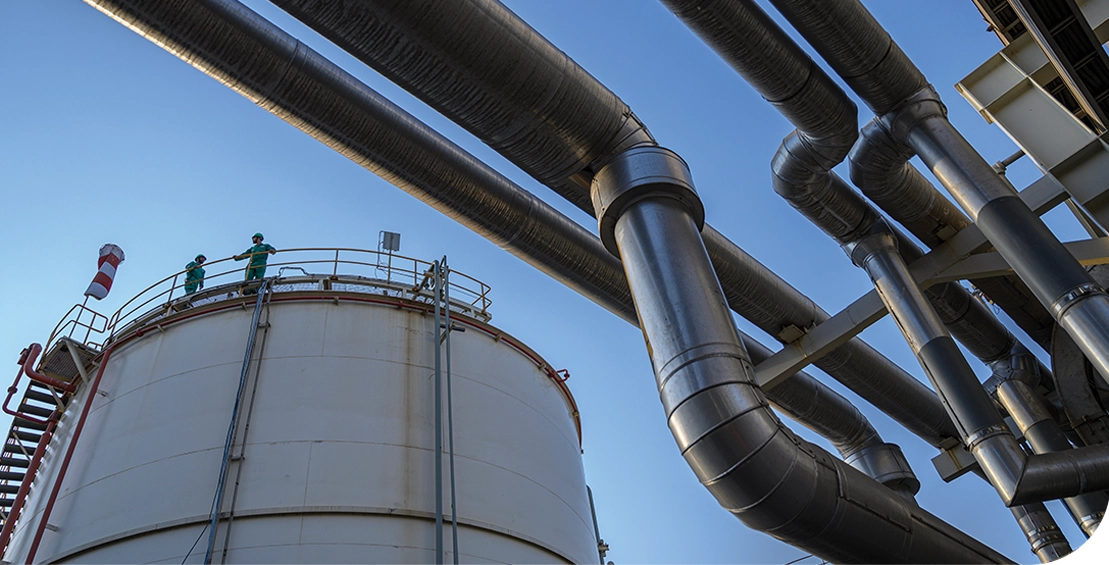
B. Exploration and Appraisal
Rajasthan - (BLOCK RJ-ON-90/1)
Rajasthan Exploration
The Rajasthan portfolio provide access to multiple play types with oil in high permeability reservoirs, tight oil and tight gas. We have completed drilling of 2 exploration wells and to unlock the potential of unconventional resources, we completed drilling of the first shale exploration well in Rajasthan during the fiscal year 2023. We are also evaluating further opportunities to drill low to medium risk and medium to high reward exploration wells to build on the resource portfolio.
Open Acreage Licensing Policy (OALP)
Under the Open Acreage Licensing Policy (OALP), revenue-sharing contracts have been signed for 51 blocks located primarily in established basins, including some optimally close to existing infrastructure, of which 5 onshore blocks in the KG region have been relinquished.
Production commenced from Jaya discovery in Cambay region in third quarter of fiscal year 2023. This is the first of its kind production facility wherein sales through CNG cascade system are being done by an E&P operator from an exploration well site.
Drilling preparations are ongoing in the Offshore West-Coast to drill a moderate risk-high reward prospect (risked resource potential of 42 mmboe) within the Kutch-Saurashtra basin during the first quarter of fiscal year 2024. We intend to continue the exploration across Rajasthan, Cambay, and North-east in FY 2024 to unlock the full potential of the OALP blocks.
Strategic Priorities & Outlook
Vedanta’s Oil & Gas business has a robust portfolio mix comprising of exploration prospects spread across basins in India, development projects in the prolific producing blocks and stable operations which generate robust cash flows.
The key priority ahead is to deliver our commitments from our world-class resources with ‘zero harm, zero waste and zero discharge':
- Infill projects across producing fields to add volume in near term
- Define up to 20 potential new development projects to bring these Resources into production
- Unlock the potential of the exploration portfolio comprising of OALP and PSC blocks
- Continue to operate at a low cost-base and generate free cash flow post-capex
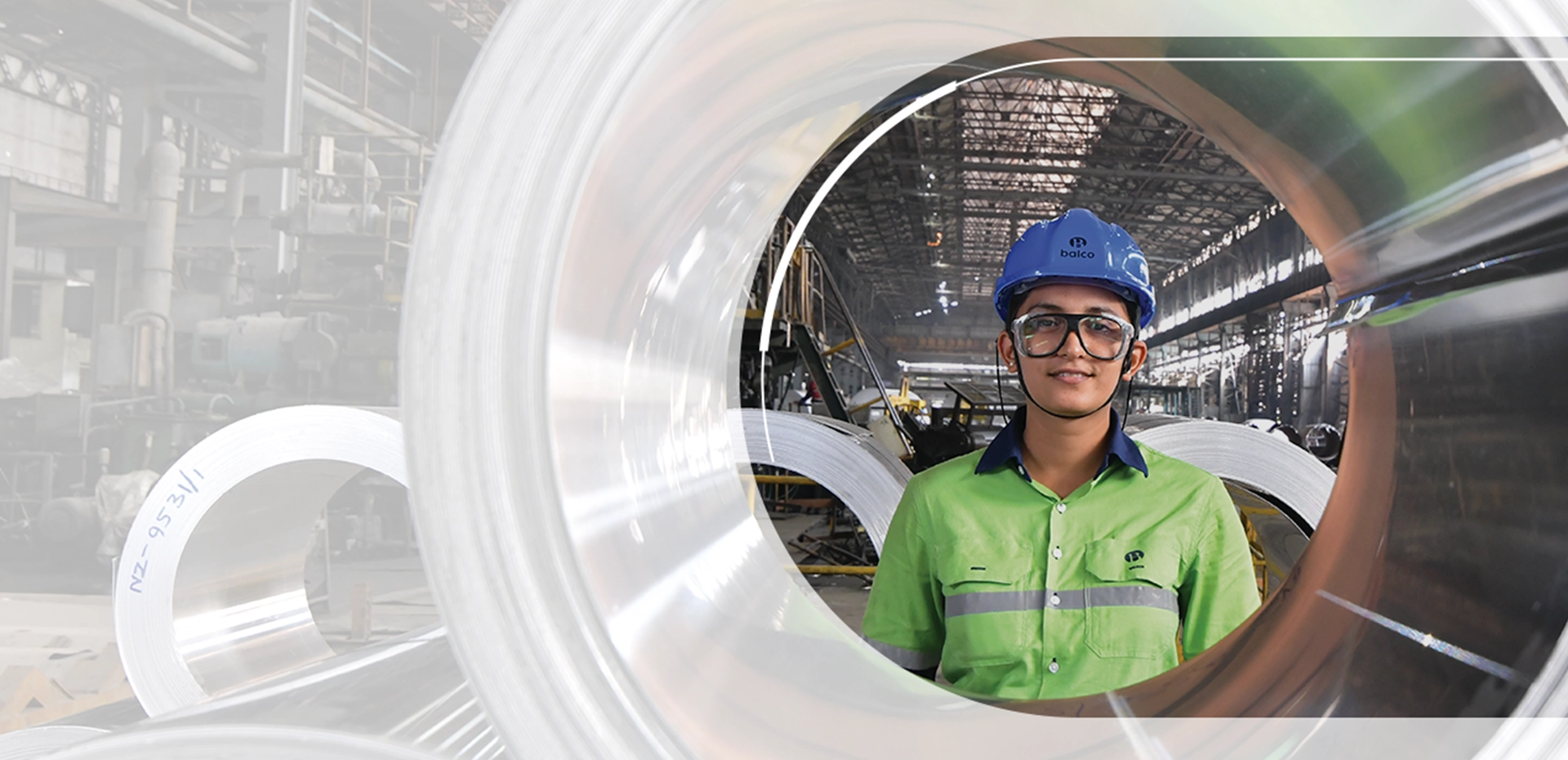
The year in brief
In FY 2023, the aluminium business achieved highest ever aluminium production of 2.29 million tonnes. It has been a remarkable year as we inched towards our vision of 3 MTPA Aluminium. Though this year we saw headwinds in cost due to rising commodity prices and the coal crisis but we undertook several structural initiatives to make our business immune from market induced volatilities. These reforms coupled with our continued focus on operational excellence, optimising our coal and bauxite mix, improved capacity utilisation across refinery, smelter and power plant, will further help reduce our cost in sustainable manner and make the business more predictable and improving our price realisation to improve profitability in a sustainable manner through well-structured PMO approach. The hot metal cost of production for FY 2023 stood at US$2,324 per tonne. We have produced 1.79 million tonnes of calcined aluminaat the Lanjigarh refinery.
2,291 kt
Highest ever aluminium production
Occupational health & safety
We report with deep regret, one fatality of business partner employee during the year at Jharsuguda site. We have thoroughly investigated all the incidents and the lessons learned were shared across all our businesses to prevent such incidents in future.
This year, we experienced total 33 Lost Time Injuries (LTIs) resulting in LTIFR of 0.41 at our operations. Further, we have developed the V-SAFE portal for timely identification and reporting of safety hazard and rectification of the same.
Towards the goal of Zero Harm in Safety, the Lanjigarh Unit undertook numerous safety measures to improve workplace condition in terms of site infrastructure, safety system & safety culture. Noteworthy infrastructural improvements include safer access pathways for pedestrians and heavy vehicles across the site. Safety systems incorporated to improve safety are introduction of Driver Management Centre, monitoring of vehicles & safe driving parameters through smart cameras, speed detectors and Vehicle Tracking System. BALCO has onboarded the journey of “Vihan” - Critical Risk Management (CRM) and launched with five critical risks control this year.
The site has also implemented digitisation project v-Unified (ENABLON) to manage safety through technological tools.
The Site is committed to ‘Refuse Work if it is Unsafe to Execute’ and empowered all site personnel to reject any activity that posed a possible safety concern.
Environment
During the year, Jharsuguda has recycled 13.09% of the water used, while BALCO has recycled 10.76%. Our specific water consumption at VLJ metal was 0.20 m3/t, BALCO metal was 0.61 m3/t and alumina refinery was 2.04 m3/t.
At Lanjigarh, biomass was co-fired in the boiler for the first time, with all defined safety measures to reduce GHG emissions (by 388 tCO2e) of the power plant. At BALCO, biomass was co-fired in the boiler for the first time (Qty: 5 kt), with all defined safety measures to reduce GHG emissions (by 6,900 tCO2e) of the power plant. Also started using biodiesel for the first time in technological vehicles and Ladle cleaning shop. This is in line with the Vedanta de-carbonisation and carbon neutrality plan.
EV vehicles will be used in operations as part of the green drive. Under this initiative, the Jharsuguda unit has deployed Electric 27 forklifts in place of diesel-propelled forklifts. We have planned to shift to 100% EV LMV by FY 2030. This will help us eliminate our in-plant scope 3 GHG emission from LMV operations at the Jharsuguda business. BALCO has planned to shift 2 EV LMVs in current year for the reduction of scope-3 emission at BALCO business.
This year, we produced 58 kt of Green Aluminium (YTD) under the brand name (Restora) with a potential to produce 100 KTPA. This is a strong step towards our commitment to achieve GHG emission intensity reduction of 30% by 2030 and Net zero carbon by 2050.
Restora Ultra is an ultra-low carbon aluminium brand in collaboration with Runaya Refining. Near zero carbon footprint – one of the lowest in the world. Testament to our focus on ‘zero waste’ through operational efficiencies and recovery from dross.
In the current fiscal year, we have reduced our GHG emission intensity by 8.3% compared to the FY 2021 baseline. We have purchased 1,323 MU of Green Power March 2023 YTD and co-fired 5,141 tonnes of Biomass. Further, the Floating Solar Project is expected to be completed by Q3 FY 2024, thus strengthening our green power commitment.
Management of hazardous waste such as spent Pot line, aluminium dross, and high volume low toxic waste such as fly ash, red mud etc. are material waste management issues for the aluminium business. During the year, our operations have utilised 106.74% of Ash and 99.34% Dross.
Vedanta Aluminium has entered into a long-term partnership with Dalmia Cements for gainful utilisation of industrial by-products such as fly-ash and Spent Pot Lining (SPL) waste to manufacture ‘green’ cement. The partnership will enable Vedanta Aluminium’s plant at Jharsuguda to transport around 20 rakes of fly ash per month for 5 years to Dalmia Cement plants at Odisha, Chhattisgarh, Meghalaya, and Assam, and transport Spent Pot Lining (SPL) waste for 3 years to Dalmia Cement at Rajgangpur, Odisha. Jharsuguda operations has implemented Integrated Waste Management System by NEPRA for sustainable management of non-hazardous waste like plastic, paper, food, horticulture waste and others. This will enable us to move towards ‘Zero Waste to Landfill’ and will help us generate wealth out of waste. Till date, total 121 rakes had been despatched which is the highest ever ash despatch for Jharsuguda unit.
BALCO is associated with Cement industries in the vicinity through road mode and striving to achieve economies of scale and enterprise solution which is environmentally friendly and cost effective. For the very purpose, BALCO has ventured into supplying the conditioned Fly Ash through Rake. This meaningful, sustainable increase in fly ash utilisation at locational, distant thermal power plant is mutual win for both Cement companies and BALCO. BALCO is also engaged in Mine back filling of Manikpur Mines which will further support the effort to utilise Fly Ash.
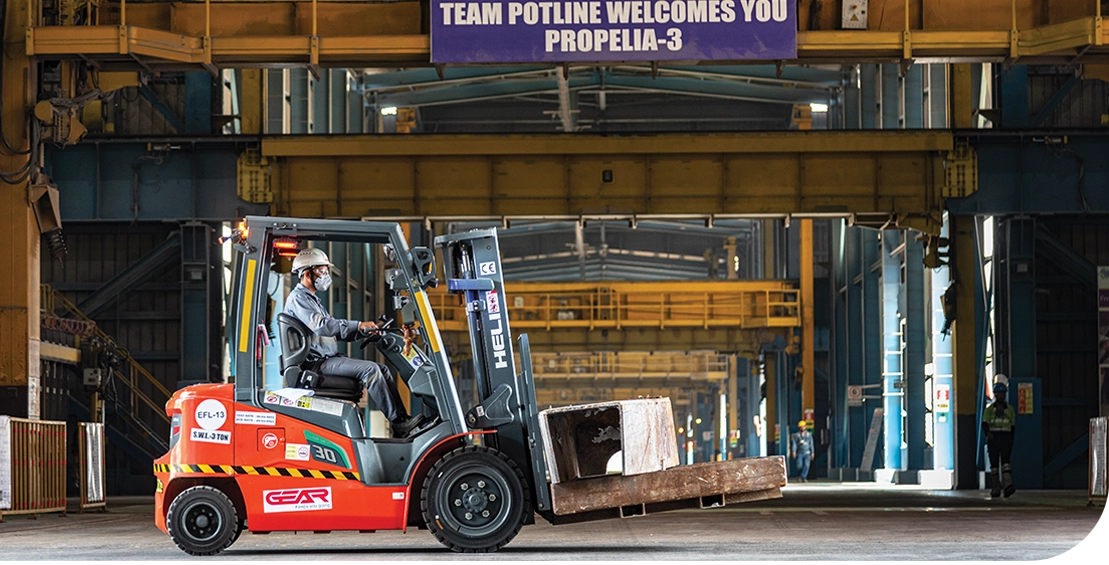
Our Lanjigarh operation has placed an order for manufacturing of red mud bricks. It is in the direction of waste-to-wealth initiative. On similar lines, JSG unit is working with Runaya refining for extracting valuable metals from Dross as part of waste-to-wealth initiatives.
The organisation is working proactively towards the vision of Zero Waste.
Production performance
Alumina refinery: Lanjigarh
At Lanjigarh, calcined alumina production stands at 1.79 million tonnes, primarily due to the calciners shutdown for overhauling.
Aluminium smelters
We ended the year with record production of 2.29 million tonnes.
Coal Security
We continue to focus on the long-term security of our coal supply at competitive prices. We added Jamkhani (2.6 MTPA), Radhikapur (West) (6 MTPA), Kuraloi (A) North (8 MTPA), Barra coal blocks and have been declared Successful Bidder for Ghogharpalli Coal Block through competitive bidding process by GoI. We have operationalised Jamkhani Coal block in FY 2023 & intend to operationalise Kurloi (A) North and Radhikapur (West) in the next fiscal year. These acquisitions, along with 15 million tonnes of long-term linkage will ensure 100% coal security for Aluminium Business. We also look forward to continuing our participation in linkage coal auctions and secure coal at competitive rates.
Prices
Average LME prices for aluminium in FY 2023 stood at US$2,481 per tonne, 11% lower YoY. Aluminium LME has been steadily declining this year, owing to a recessionary market outlook coupled with the zero Covid policy of China. However, with the opening of the Chinese economy coupled with the decrease in the inflationary pressure, the LME prices is expected to rebound. Further, the aluminium market is in a growth phase now with demand expected to be driven by sunrise sectors such as Electric Vehicle, Renewable Energy, Defence and Aerospace.
Unit costs
During FY 2023, the cost of production (CoP) of alumina increased to US$364 per tonne due to lower production and headwinds in the input commodity prices.
In FY 2023, the total bauxite requirement of about 5.5 million tonnes were met through domestic as well as import sources.
In FY 2023, the COP of cast metal at Jharsuguda was US$2,291 per tonne, an increase by 25% from US$1,839 per tonne in FY 2022. The cast metal COP at BALCO stood at US$2,424 per tonne, increased by 27% from US$1,913 per tonne in FY 2022. This was primarily driven by theheadwinds in input commodity prices.
Financial performance
During the year, revenue increased by 3% to ₹52,403 crore, driven by improved operational performance, strategic hedging gains, favourable exchange rate movement partially offset by reduced LME. EBITDA was down at ₹5,837 crore (FY 2022: ₹17,337 crore), mainly due to fall in LME, input commodity inflation partially offset by favourable exchange rate movements.
Strategic Priorities & Outlook
Our focus remains on capitalisation of market opportunities through execution of right levers. Foremost priority remains delinking production cost from external volatility. Lanjigarh expansion activities is underway with full force and an upside in volume is expected in the upcoming year. Vedanta Limited was also declared the preferred bidder for Sijimali at the recently concluded Bauxite mine auction. The same would be instrumental in meeting requirement for 5 MTPA refinery operations. Full capacity production run rate at recently started Jamkhani mine should ease our dependence on spot market coal. This would be further augmented by operationalisation of other mines in the short to medium term. Effort would also be continued towards achieving better than best achieved operational performance along with increased volume delivery through debottlenecking and growth projects.
Our core business priorities include:
ESG: Safety & Well-being of all stakeholders, Low Carbon Green Aluminium Production (Restora, Restora Ultra), Diversity in Workforce, Circular Economy
Asset Optimisation: >100% capacity utilisation of assets through implementation of structured asset reliability program
Raw Material Security: Operationalise Sijimali bauxite mine, Lanjigarh expansion to 5 MTPA
Coal Security: Operationalise coal mines and improve linkage materialisation
Quality: Zero customer complaints
Operational Excellence: Continual improvement in operational parameters
Growth: 1 MTPA BALCO smelter expansion, >100% value-added capacity
Product Portfolio: Improve value-added product portfolio with focus on low carbon aluminium for better realisation.
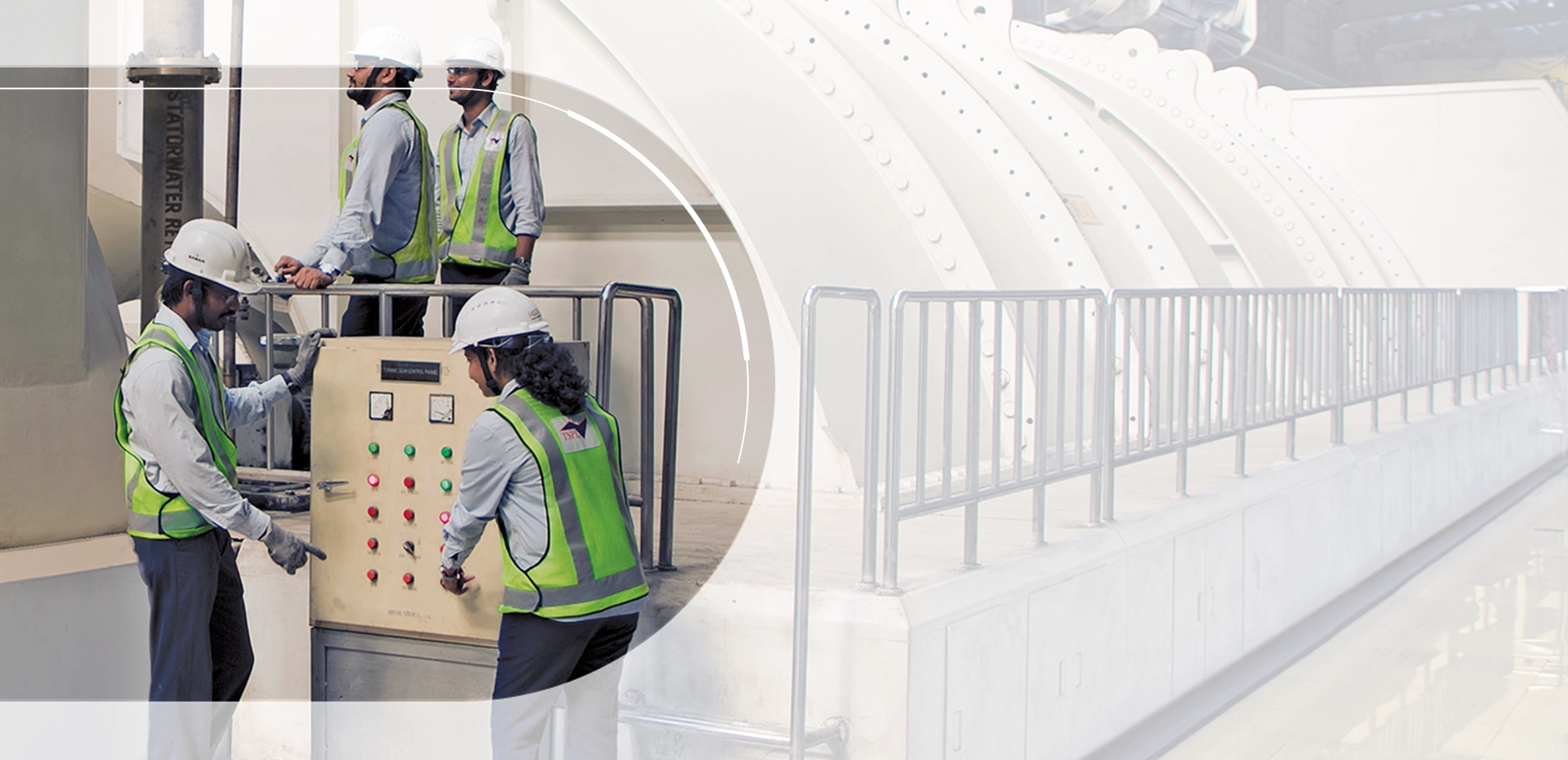
The year in brief
In FY 2023, TSPL’s (Talwandi Sabo Power Limited) plant availability was 82% and Plant Load Factor (PLF) was 67%.
14,835 million units
Record overall power sales
Occupational health & safety
In FY 2023, TSPL focus on Category 5 Safety Incident elimination such as Critical Risk Management, Catastrophic Risk Management, Horizontal Deployment of Safety Alert Learnings,, Vedanta Safety Standard Implementation and Engineering/Controls such as Line of Fire Prevention and Safety improvement project.concern.
We continue to strengthen the ‘Visible Felt Leadership’ through the on-ground presence of senior management, improvement in reporting across all risk and verification of on-ground critical controls. We also continue to build safety assisting infrastructure development through the construction of pedestrian pathways, dedicated route for bulkers, creation of secondary containment for hazardous chemicals and other infra development across sites.
Environment
TSPL focus on environment protection measures such as maintaining green cover of over 800 acres, continue the expansion of green cover inside plant premises and nearby communities. TSPL ensures availability of environment protection system such as ESP, Fabric Filters, Water Treatment Plant and RO Plant. In Tailing Dam Management, TSPL has implemented all the recommendation of M/s Golder Associates for ash dyke. Additional GISTM Conformance Assessment of TSPL Ash Dyke Facility by ATC Williams, Australia & TATA Consultancy (TCE) as Engineer of Records (EOR) to ensure Ash Dyke stability to review dyke design, quality assurance during for ash dyke raising and quarterly audit of ash dyke facility. In FY 2023, TSPL achieved 83% Ash utilisation in Road Construction, in Building sector for bricks, blocks, cements and lowlying area filling. TSPL has signed various MoUs with stakeholders to increase ash utilisation.
TSPL has recycled 12.62% of the water used & reduce the fresh water consumption by various operation controls. TSPL continues its focus on energy saving projects such as High Energy Efficient Booster Pump at Unit#02, CWP RPM reduction, HPT performance improvement, replacement of conventional lighting fixtures with LED lighting fixtures.
To stimulate efforts and reach towards new heights of sustainable business practices, TSPL established ESG transformation office. Under this initiative, TSPL has accelerated its efforts in Environment, Social and Governance aspects. TSPL ESG Transformation Office was created which included 12 communities of practice from each aspect of sustainability. Communities of Practice included Carbon, Water, Waste, Biodiversity, Supply Chain, People, Communities (CSR), Communication, Safety and Health, Acquisitions, Expansions. Each Community is led by a senior leader in the concerned department. Each community is driving sustainability initiatives in their community. In FY 2022-23, 45 new projects were identified, 38 initiatives completed and 62 improvement initiatives are in progress.
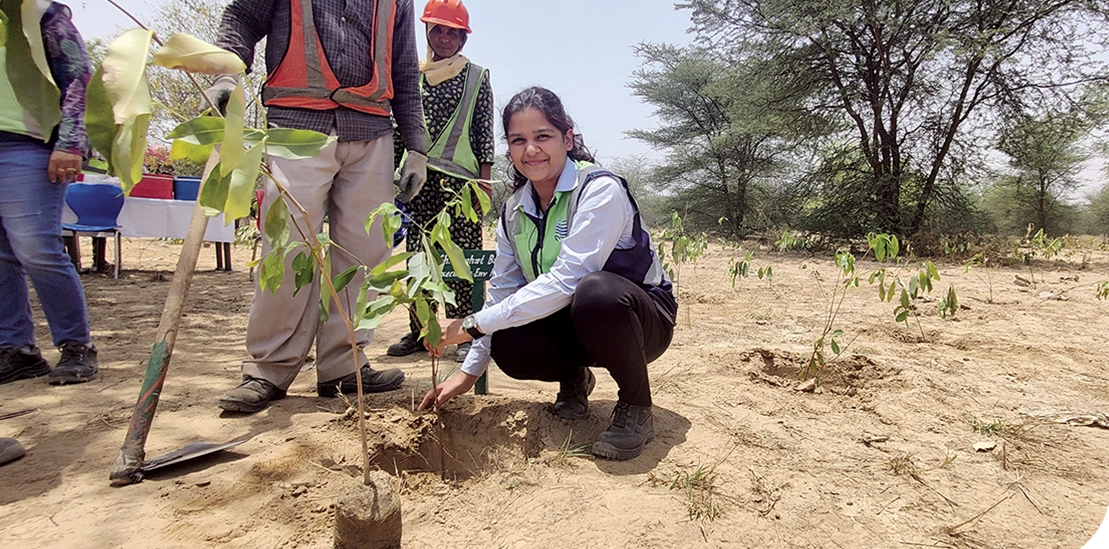
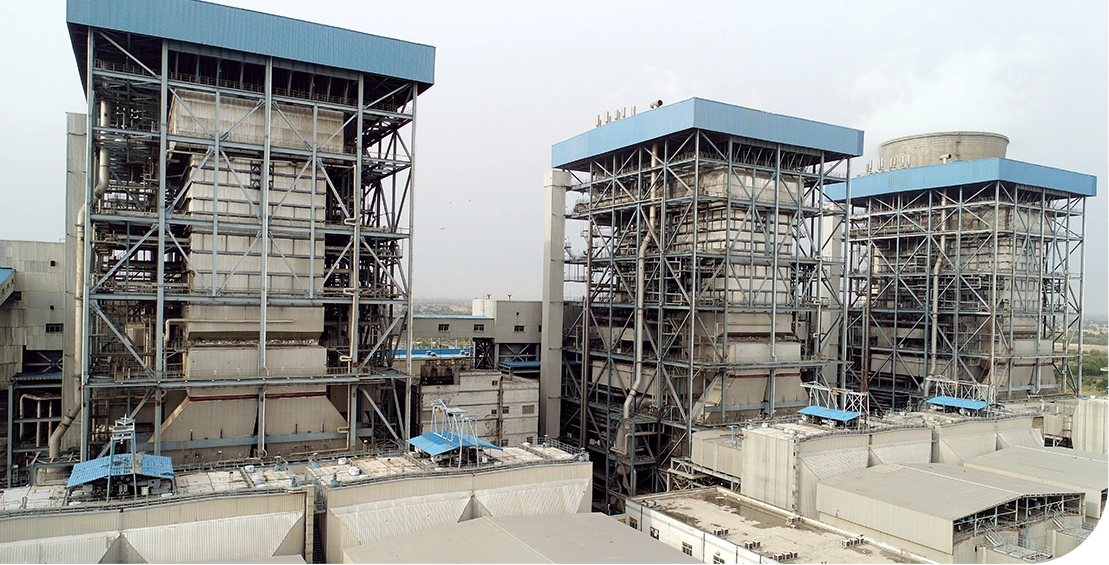
Production performance
# Malco continues to be under care and maintenance since 26 May 2017 due to low demand in Southern India.
* We have received an order dated 01 January 2019 from CSERC for Conversion of 300 MW IPP to CPP w.e.f. 01 April 2017. During the Q4 FY 2019, 184 units were sold externally from this plant
Operations
During FY 2023, power sales were 14,835 million units, 25% higher YoY. Power sales at TSPL were 10,744 million units with 82% availability in FY 2023. At TSPL, the Power Purchase Agreement with the Punjab State Electricity Board compensates us based on the availability of the plant.
The 600 MW Jharsuguda power plant operated at a lower plant load factor (PLF) of 63% in FY 2023.
The 300 MW BALCO IPP operated at a PLF of 66% in FY 2023.
The MALCO plant continues to be under care and maintenance, effective from 26 May 2017, due to low demand in Southern India.
Unit sales and costs
Average power sale prices, excluding TSPL, lower by 2% and the average generation cost was lower at ₹2.38 per kWh (FY 2022: ₹2.42 per kWh).
In FY 2023, TSPL’s average sales price was higher at ₹4.50 per kWh (FY 2022: ₹3.62 per kWh), and power generation cost was higher at ₹3.65 per kWh (FY 2022: ₹2.76 per kWh).
Financial performance
EBITDA for the year was 21% lower YoY at ₹851 crore from ₹1,082 crore.
Strategic priorities & outlook
During FY 2023, we will remain focussed on maintaining the plant availability of TSPL and achieving higher plant load factors at the BALCO and Jharsuguda IPPs.
Our focus and priorities will be to:
Resolve pending legal issues and recover aged power debtors;
Achieve higher PLFs for the Jharsuguda and BALCO IPP; and
Improve power plant operating parameters to deliver higher PLFs/availability and reduce the non-coal cost;
Ensuring safe operations, energy & carbon management.
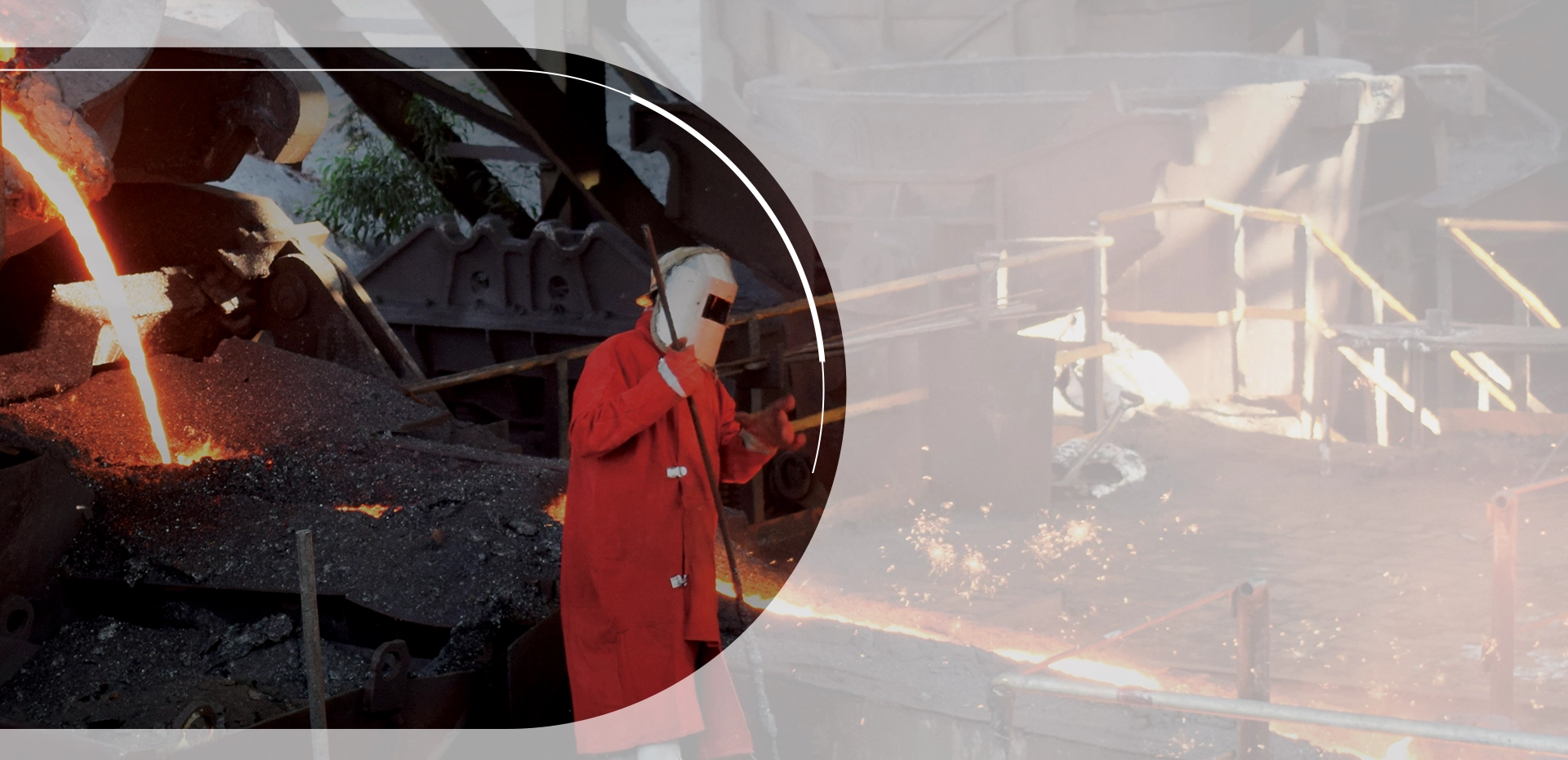
The year in brief
- Removal of trade barriers from Karnataka resulted in quick restart of export and enabled us to capture ~99% Export share from Karnataka
- Restart of WCL Operations and successfully exported 0.2 million tonnes in this financial year
- Acquisition of Bicholim mines at lowest bid premium among all iron ore mines auctioned in FY 2023
5.3 million tonnes
Production of saleable ore at Karnataka
696 kt
Pig Iron production
0.7 million tonne
Iron ore sales at Goa
Occupational health & safety
With our vision towards the aim of Zero Harm, we are committed to achieve zero fatal accident at Iron Ore Business. Our Lost Time Injury Frequency Rate ("LTIFR") is 0.79 (FY 2023) compared to 0.83 (FY 2022). We are now focussing on bringing down the number of injuries by conducting a detailed review of critical risk controls through critical task audits, strengthening our work permit and isolation system through identification and closure of gaps, on site audits, increasing awareness of both Company and business personnel by conducting trainings as per requirements considering the sustainability framework.
We have strived to enhance the health and safety performance by digitalisation initiatives such as usage of non-contact type voltage detectors, underground cable detectors. We have also implemented AI cameras (T-Pulse system) for reporting of unsafe acts/conditions automatically in areas where Camera infrastructure is available with central dashboard with all details, analysis, trends and risk category, which ensures effective and immediate closure of violations at site. At VAB, we have done Geo fencing to ensure unauthorised entries in most critical operational areas.
Vedanta has launched a HSE-based portal by name V‑Unifined (Enablon) for reporting, collating and analysing the HSE-related data across the Business which has become a way of life since its inception during the Financial Year.
At VAB and IOK, we have launched 4 Critical Risk Management (CRM) verification by Line Managers and the observations are being tracked, analysed and rectification plan is in place. We have achieved target of 75% vs Planned.
In Health function, we have also launched SEVAMOB digital platform for digitisation of Employee Medical Records which help us in tracking and giving health-related trend analysis of employees.
In order to achieve highest levels of safety at site, we have identified key personnel from operation and maintenance to serve as Grid Owners in addition to their current roles and responsibilities. We have also conducted defensive driving trainings to further enhance driving skills thereby reducing the vehicle-related incidents. At VAB, we have conducted a training on crane and lifting safety for approving critical lift plan and better focus on safety in areas of lifting and critical lifts. We have also conducted rescue training for Confined space and Work at Height through a third party so as to authorise a shortlisted group of competent personnel as trained rescuers. To improve upon confined space safety, we have conducted “Authorised Gas Testers” training programme to strengthen our Confined space activities.
At IOK, we have conducted rescue trainings through a third-party for Confined Space and Work at Height. Traffic Management & Road Safety Training was conducted by Rashtriya Raksha University involving selected employees and Business Partners. 4 modules of AR-VR have been launched at IOK which includes LMV operation, wheel loader operation, fire extinguisher operation and engine maintenance.
In FY 2024, we will be further launching remaining Safety Standard through CRM for strengthening our Fatality Prevention Programme.
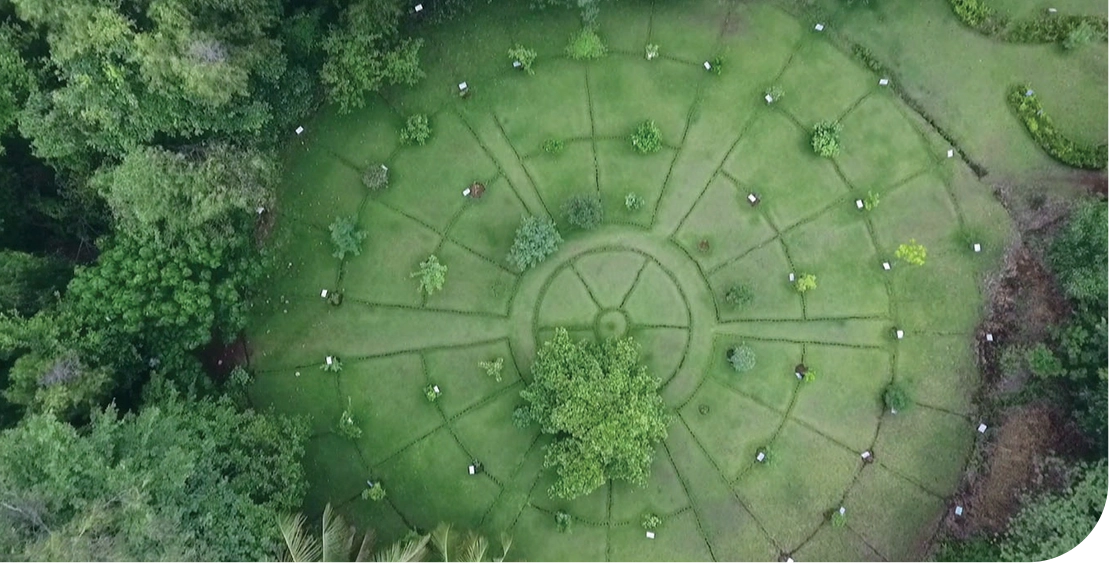
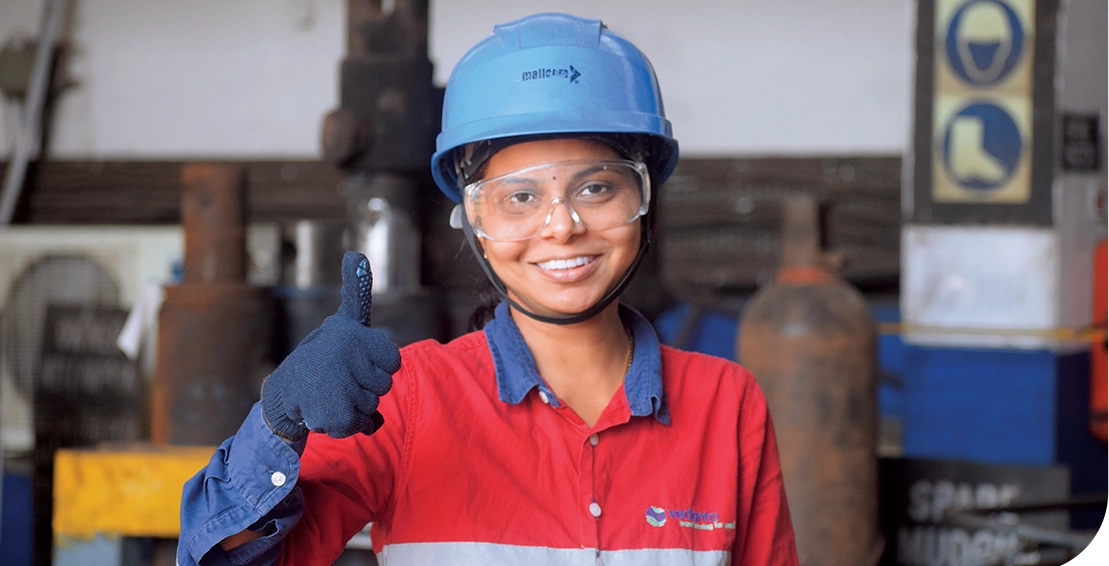
Environment
At our Value-Added Business, we recycle and reuse all the process water. Only the non-contact type condenser cooling water of the power plant is cooled and treated for pH adjustment and discharged back into the Mandovi river, which is a consented activity by the authorities.
1,560 numbers of native species were planted in the year 2022-23 in green belt area of VAB along with 1,850 no. of native species plantation was done in surrounding villages of VAB.
Also, Value Added Business received Consent to establishment for expansion project for installing Ductile Iron plant, oxygen plant & Ferro Silicon Plant along with increasing hot metal production capacity.
At Iron ore Karnataka, continuing with its best practises, Company has constructed 38 check dams, 7 settling pond. Additionally, Company has de-silted 2 nearby village ponds increasing their rainwater harvesting potential by 20,000 m3/annum.
In FY 2023, around 6 Ha of mining dump slope was covered with biodegradable geotextiles to prevent soil erosion & 55,000 native species saplings were planted. Various latest technologies like use of fog guns; environment-friendly dust suppressants mixed with water were adopted on the mines to reduce water consumption for dust suppression without affecting the effectiveness of the measures.
Production performance
Operations
At Karnataka, production was 5.3 million tonnes. Sales in FY 2023 were 5.7 million tonnes, 17% lower YoY. Production of pig iron was 6,96,559 tonnes in FY 2023, lower by 12% YoY due to shut down in blast furnaces in FY 2023.
At Goa, mining was brought to a halt pursuant to the Supreme Court judgement dated 7 February 2018 directing all companies in Goa to stop mining operations with effect from 16 March 2018.
We bought low grade iron ore in auctions held by Goa Government in Auction No. 26 & 27 in FY 2022. This opening stock of ore purchased in the auction and fresh royalty paid ore moved out of mines post the Supreme Court order, was then beneficiated and around 0.7 million tonnes were exported which further helped us to cover our fixed cost and some ore were used to cater to requirement of our pig iron plant at Amona.
Financial performance
In FY 2023, revenue increased to ₹6,503 crore, 2% higher YoY mainly due to restart of WCL operations. EBITDA decreased to ₹988 crore compared with ₹2,280 crore in FY 2022 was mainly due to decrease in sales at Karnataka and VAB andinput commodity inflation.
Strategic priorities & outlook
Our near-term priorities comprise:
Restart mining operations at Goa
Ramp up our operations in Liberia and setting up magnetite concentrator plant
Green Mining leveraging, digitalisation, and Renewable energy
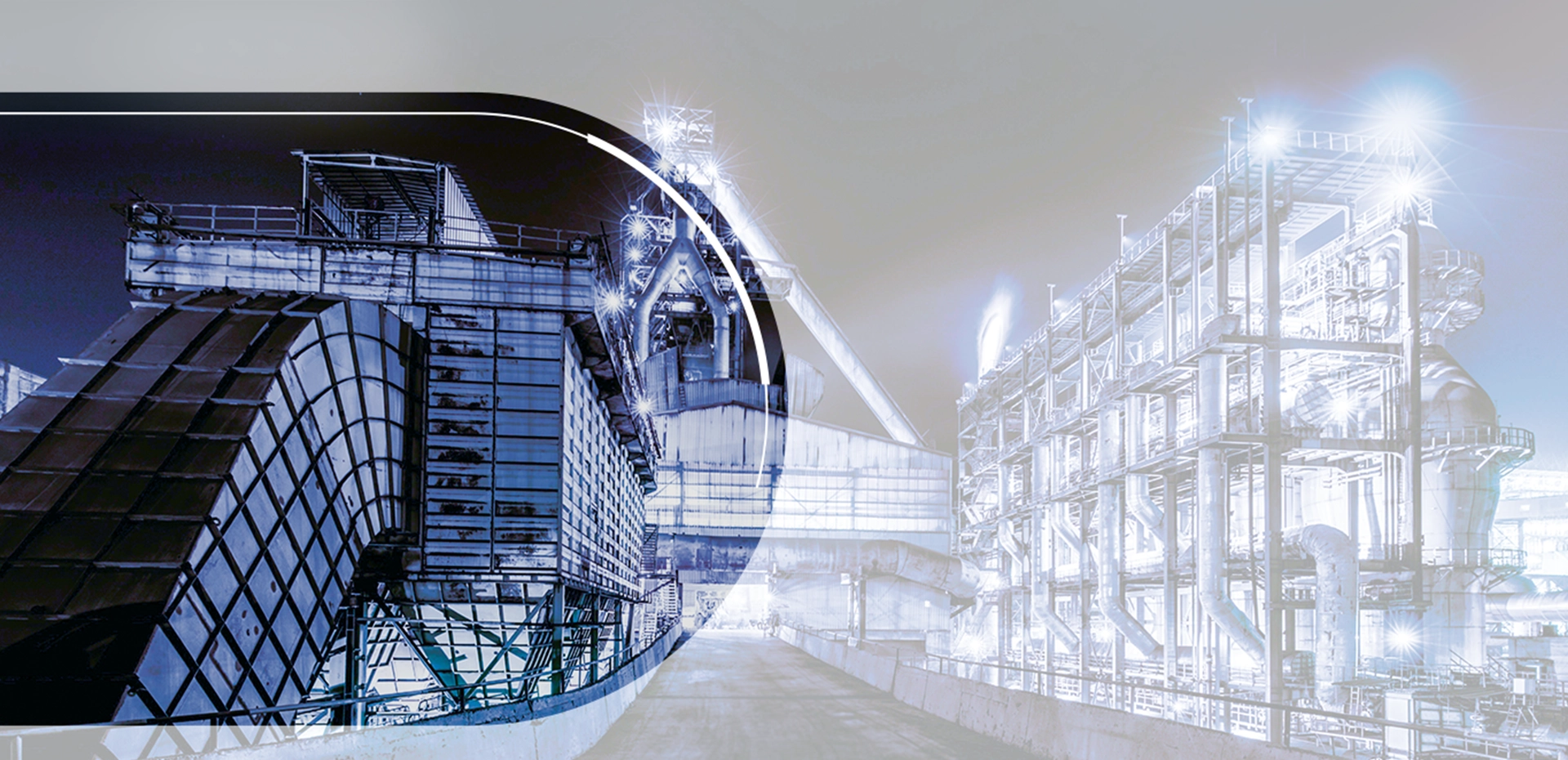
The year in brief
ESL is an integrated steel plant (ISP) in Bokaro, Jharkhand, with a design capacity of 2.5 MTPA. Its current operating capacity is 1.5 MTPA with a diversified product mix of Wire Rod, Rebar, DI Pipe and Pig Iron.
In FY 2023, ESL Steel Limited (ESL) has achieved highest ever hot metal production of 1.37 million tonnes, up 1% YoY and highest ever saleable production of 1.29 million tonnes up 2% YoY.
196 kt
Highest ever DIP production
20% YOY1.29 million tonnes
Saleable production
ESL HSE/ESG Performance
Occupational Health & Safety
We, at ESL, believe that all accidents are preventable and to realise our vision of Zero Harm, we have carried out the following key initiatives for nurturing ZERO HARM culture across organisation.
- Launched Project VIHAAN – Critical Risk Management to verify critical risks Go and NoGo implementation periodically for various critical controls viz.
- Digital Initiatives – Launched Cardinal Safety Rule Portal, Kiosk-based safety induction for drivers and QR-based fire equipment maintenance and tracking
- Capability Building – Engaged DuPont to train and develop trainers for implementing various safety standards (160+ developed through TTT)
- Occupational Health – Engaged M/s Apollo for managing OHC & Air Ambulance services, initiated medical consultation facility for employees and their families at Bokaro City and developed 500+ trained first aiders
- Infrastructure – Conveyor guarding, drain covering, fire hydrant line revamping, settling pits, tarpaulin covering/uncovering platforms and man machine segregation across the plant roads
Environment
Waste and Circular Economy
We have achieved 100% utilisation of BF granulated slag and fly ash by re-using in cement plants & local brick manufacturers. Other types of waste viz., bottom ash, LD slag & core mould sand, we have achieved 98% of its utilisation by internal road making & mines back filling. Hazardous wastes are being sent to PCB authorised recyclers/re-processors.
Climate Change
- Reduction in False Air/Air leakages in Sinter Plant, Sinter Plant bed depth control, Fuel crushing index improvement has resulted in estimated decrease of tonnes of CO2e by 35,000 tonnes of CO22e
- LD gas recovery project has been undertaken by repairing and revamping the Gas Holder facility, which has led to an estimated decrease of 18,480 tonnes of CO2e
Biodiversity/Plantation
- ESL has achieved 34.54% green belt development
- Around 25,000 saplings have been planted inside KML to drive greenbelt development project
- 10,000 fruit-bearing saplings have been distributed among 9 panchayats to drive greenbelt development in surrounding areas of ESL
- Miyawaki afforestation of 2.5 acre has been commenced in Q4 with the target of about 55,000 saplings
Water Management
- 2 nos. of rainwater settling pits along with pumps have been installed to contain the flow from the stormwater drains across the plant. This has resulted in increase in ETP water intake and optimised the usage of stormwater by 350-400 KLD
- 250 KLD sewage treatement plant has been commissioned during Q4 which would reduce fresh water offtake by 250 KL/day. This would ensure saving of fresh water by 90,000 KL/annum
- Green Belt Development – Planted more than 35,000 samplings including 10,000 fruit-bearing saplings, achieved 33% greenbelt requirement this year
- ESG – 60 projects have been identified out of which 10 have been completed and 34 have achieved IL 4 stage
- Sp. Water – We have reduced our fresh water offtake from the reservoir by 1.7 million m3 through the following water stewardship programme. This has resulted in achieving specific water consumption of 2.88 m3 /tcs from 3.00 m3/tcs
- Arresting water leakages and replacing firefighting pipelines
- Increasing recycle percentage through installation of ZLD pump from 12% to 24%
- Increasing cooling tower COC from 6 to 7
- Cleaning of backwash pipeline
- Sp. Energy & GHG Emissions - Against the target of 7.97 Gcal/tcs, we have achieved 7.72 Gcal/tcs (YTD), several initiatives were taken such as:
- Optimisation of compressor, blower speed, CT fans, AC & Light operation, power consumption of other circuit hot water circulating pumps by installing VFD with feedback system
- Reduction in False Air/Air leakages in Sinter Plant, Sinter Plant bed depth control, Fuel crushing index improvement has resulted in estimated decrease of tonnes of CO2e by 35,000 tonnes of CO2e
- Blast furnace dedusting damper auto control
- Improving fuel rate by 20 kg/tcs for BF3 and 7 kg/tcs for BF2 resulting in reduction of 64,846.6 tonnes of CO2e
Production performance
Operations
During FY 2023, we have achieved highest ever hot metal production of 1.37 million tonnes, up 1% YoY and highest ever saleable production of 1.29 million tonnes, up 2% YoY on account of increased availability of hot metal due to debottlenecking of blast furnace and operational efficiencies.
The priority remains to enhance production of value-added products (VAPs), i.e., TMT Bar, Wire Rod and DI Pipe. ESL achieved 83% VAP sales, 5% improvement in FY 2023, in line with priority.
There have been significant gains in Sales & NSR front. However, operational inefficiencies, higher raw material prices of coking coal & other market factors resulted in higher cost of sales. We are trying to stable our raw material prices. We have acquired two iron ore mines to achieve raw material long-term security & pricing stability.
Our Consent to Operate (CTO) for the steel plant at Bokaro, which was valid until December 2017, was not renewed by the Jharkhand State Pollution Control Board (JSPCB). This was followed by the Ministry of Environment, Forests and Climate Change (MoEF&CC) revoking the Environmental Clearance (EC) dated 21 February 2018. MoEF&CC, on 25 August 2020, has granted a Terms of Reference to ESL for 3 MTPA plant with conditions like fresh EIA/EMP reports and public hearing. The Honorable High Court of Jharkhand had extended the interim protection granted in the pending writ petitions till 16 September 2020. Hon’ble High Court on 16 September 2020, pronounced and revoked the interim stay for plant continuity w.e.f 23 September 2020. ESL filed a SLP before Hon’ble Supreme Court against 16 September 2020, order for grant of interim status quo order and plant continuity. Vide order dated 22 September 2020, Hon’ble Supreme Court issued notice and allowed plant operations to continue till further orders. In furtherance of the Supreme Court orders for plant continuity, MoEF vide its letter dated 2 February 2022 has deferred the grant of Environment Clearance till Forest Clearance Stage-II is granted to ESL. ESL has submitted its reply against MoEF letter vide letter dated 11 February 2022 for reconsidering the decision and not linking EC with FC since as per the applicable law and available precedents, grant of FC Stage-II is not a condition precedent for grant of EC. CTO will be procured post furnishing the EC. The grant of FC was kept at abeyance for want of Forest Clearance. FC Stage-I is granted to ESL, while the FC compliance are under process.
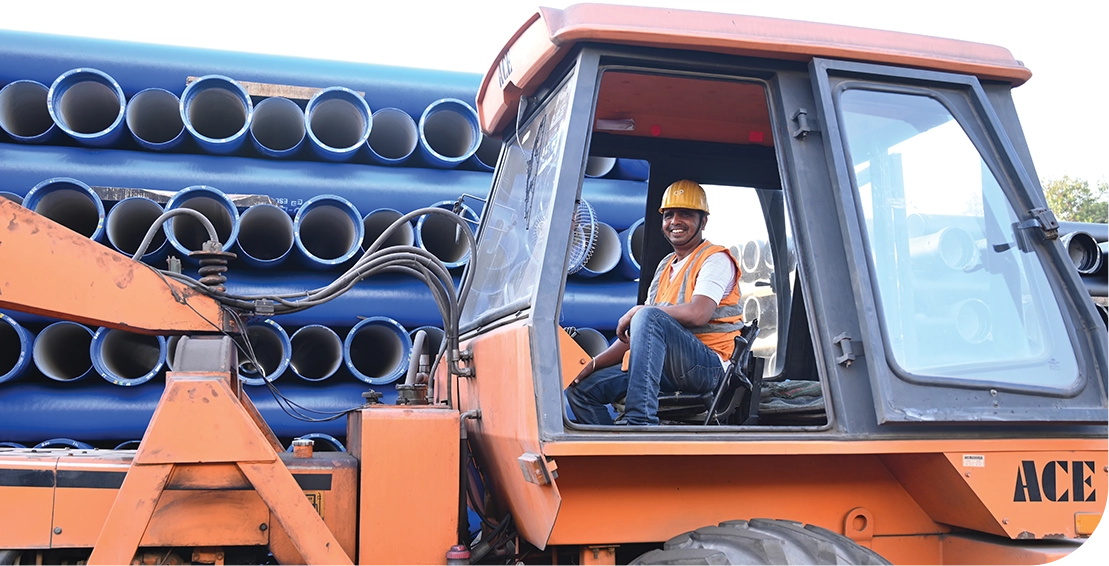
Prices
Average sales realisation increased 4% YoY from US$659 per tonne in FY 2022 to US$689 per tonne in FY 2023. Prices of iron and steel are influenced by several macro-economic factors. These include global economic slowdown, US-China trade war, Russia-Ukraine war, duties on iron and steel products, supply chain destocking, government expenditure on infrastructure, the emphasis on developmental projects, demand-supply dynamics, the Purchasing Managers’ Index (PMI) in India and production and inventory levels across the globe especially China. Even though the NSR increased by US$29 per tonne, we were unable to increase our EBITDA margin & landed to US$32 per tonne for the year (against US$74 per tonne in FY 2022) due to increased raw material prices of coking coal, which continued to remain high in in Q2 and Q3, when the market prices for steel products declined sharply.
Unit costs
Cost has increased by 12% YoY from US$585 per tonne to US$656 per tonne in FY 2023, primarily on account of increase in coking coal prices during the year, uncontrollable factors and operational inefficiencies.
Financial performance
Revenue increased by 21% to ₹7,852 crore (FY 2022: ₹6,474 crore), primarily due to higher volume and NSR. EBITDA decreased by 55% to ₹316 crore mainly due to increased cost partially offset by increased sales realisation.
Strategic priorities & outlook
Steel demand is expected to surge owing to the gradual recovery in economic activities across the world, robust demand from key sectors and the emphasis of governments to ramp up infrastructure spend in India. With the growing demand for steel in India, ESL has prioritised to increase its production capacity from 1.5 MTPA to 3 MTPA by FY 2025 and 5 MTPA by FY 2027 with a vision to become high-grade, low-cost steel producer with lowest carbon footprint. The focus is to operate with the highest Environment, Health and Safety standards, while improving efficiencies and unit costs.
The focus areas comprise:
Ensuring business continuity
Innovation in Technology for sustainable operations/production
Development of low-cost CapEx products (Alloy Steel Segments and Flat Products) to capture market share
Optimise and significantly reduce logistics cost over time
Greater focus on Reliability Centred Maintenance
Obtain clean ‘Consent to Operate’ and environmental clearances
Raw material securitisation through long-term contracts; approaching FTA countries for coking coal
Ensure zero harm and zero discharge, fostering a culture of 24x7 safety culture
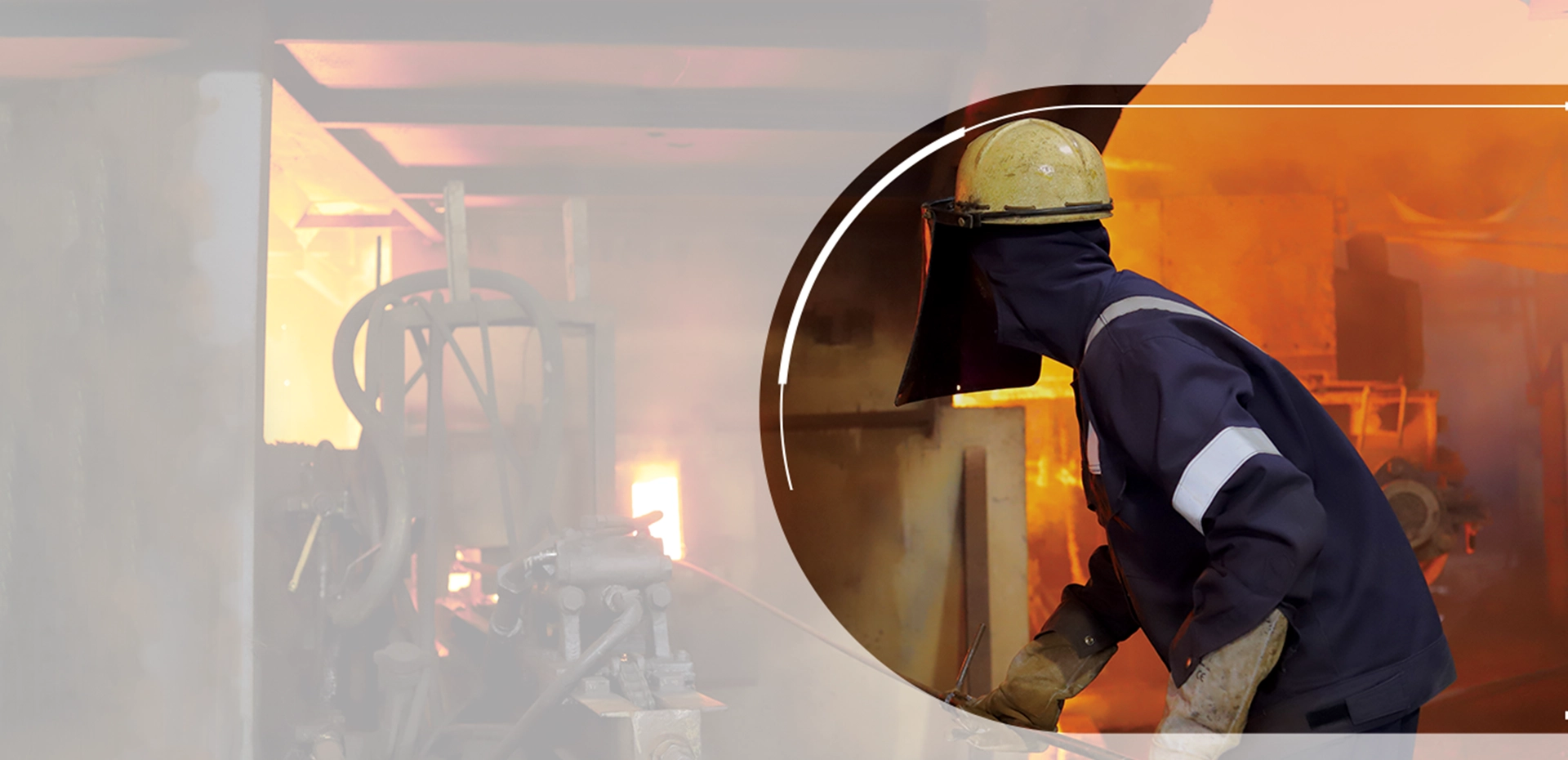
The year in brief
FACOR has achieved highest ferro chrome ore production of 290 kt, since acquisition through operationalisation of two ore mines. Also achieved high ferro chrome production of 67 kt and sales of 67 kt.
60 KTPA
Commissioned new furnace
140 KTPA
Total ferro-chrome capacity reached
290 kt
Record chrome ore production
Occupational Health Safety
It is with deep sadness that we report the loss of two of our colleagues (Business partners) in work-related incidents at our managed operations in FY 2023, one each at Mining site and at Plant site. These incidents happened despite continuous efforts to eliminate fatalities and attain a Zero Harm work environment. A thorough investigation was conducted to identify the causes of these incidents and to share lessons learned across our sites, with the aim of preventing repeat or similar incidents.
LTIFR for the year was 0.13 as compared to 0.25 in FY 2022. The reduction was driven by several safety awareness, investigation, and prevention initiatives. As compared to a year ago, number of LTIs decreased from 2 to 1 in this FY 2023. There has been greater management focus to bring a cultural change via felt leadership programs, town halls & recognition for near-miss reporting. Our safety leadership regularly engages with the business partner site in-charges and their safety officers for their capability development and strengthening the culture of safety at our sites. We follow a zero-tolerance policy towards any safety related violations with stringent consequence management.
In FY 2023, FACOR complied with all its statutory requirements related to its Health, Safety and Environment. In terms of Safety, we continued creating awareness on various Safety topics through Monthly Safety Themes and Awareness programs. We successfully eliminated a few critical jobs from line of fire with “Installation Wagon Pusher Device at our Wagon Tripler area” and “Shifting of Ladle Cleaning area out of the hot metal handling zone”. We also completed our major Furnace relining job safely. AI-based Safety System “T-Pulse” was installed in CCTV Cameras of Charge Chrome Plant (CCP) Hot Metal Area to auto detect Unsafe observations. For Risk Management, EOT Cranes were provided with Anti-Collison device and AudioVisual Alarm, Silpaulin were installed on weak benches of the Mines dump, Proximity sensors and Semi Fire Suppression System (SFSS) were installed at all Mines Dumpers and Inhouse Machine Guarding work was done throughout all the Conveyors across all the units.
Environment
For environment, on statutory front, Environment Clearance and Consent to Establish (CTE) was obtained for 33 MVA Furnace and Consent to Operate (CTO) was extended for Kalarangiatta Mines. We started utilising Spent resin which is a hazardous waste in our Powerplant (FPL) boiler after due approvals. For the first time, we started disposing our Plastic waste from both Plant and Mines to authorised vendors. Plantation of more than 12,000 saplings were conducted across all units of FACOR.
Our business is committed to protect the environment, minimise resource consumption and drive towards our goal of Net Water Positivity and 100% Waste utilisation. A few more highlights for FY 2023 are:
Installation of a new Sewage Treatment Plant
Installation of Weather Monitoring Station
Installation of Ambient Air Quality Monitoring System (AAQMS)
Conducted CGWA Water Audit and Ground Water Impact Assessment
Velocity of flue gas – Installation of Stack & integrated with CEMS data at FPL
Installation of CEMS analysers at Gas Cleaning Plant
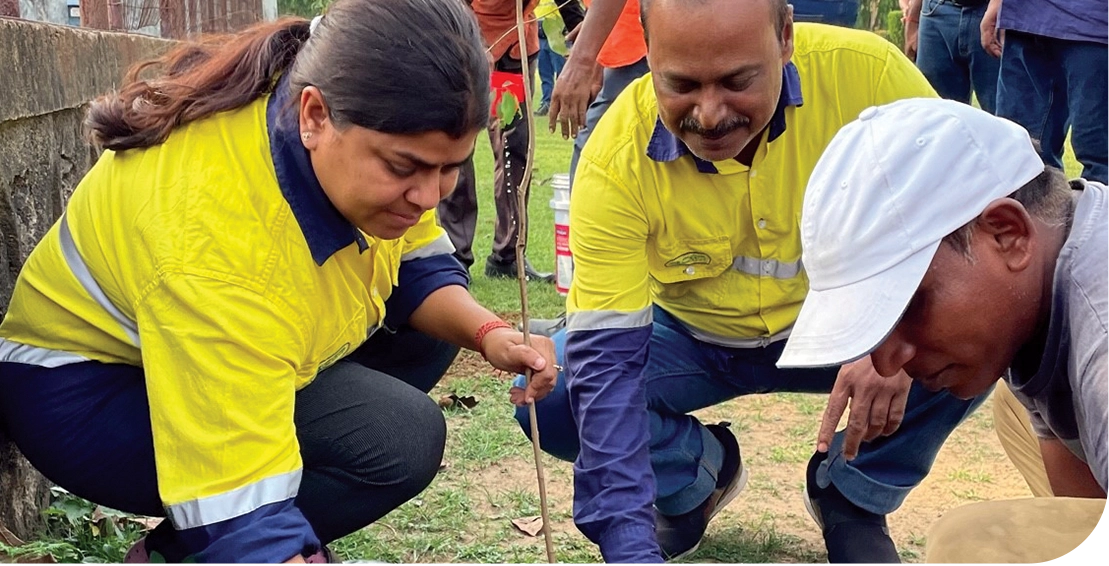
Production performance
At Mining division, we recorded highest ever Chrome Ore production of 290 kt in FY 2023 since acquisition. Through disrupt ideas and out of the box thinking, we also achieved highest ever monthly and quarterly Ore Production of 49 kt in April 2022 and 140 kt in Q1 FY 2023 since acquisition. Ensuring our commitment towards zero harm, we have installed fatigue monitoring systems, AFDSS and proximity sensors in all tippers. The mining division has achieved a milestone in observational reporting since FY 2022, through state-of-the-art inhouse developed ‘FACOR – SO’ mobile application along with geo-tagging.
At Charge Chrome Plant (CCP), We recorded Ferrochrome metal volume of 67 kt in FY 2023. We started blending Met Coke with Anthracite coal and Coke Fines Briquettes and were able to achieve average blending of 20% (15% Anthracite Coal and 5% Coke Fine Briquettes) in FY 2023 from 14% of FY 2022. We also reduced our specific Power consumption up to levels of 3,316 kWh/t against 3,345 kWh/t. In the month of January 2023, we have made second highest ferro chrome production of 6,840.
Financial performance
Revenue decreased by 8% to ₹768 crore (FY 2022: ₹830 crore), primarily due to lower sales volume. EBITDA decreased by 54% to ₹149 crore mainly due to lower sales volume and higher cost.
Strategic priorities & outlook
Expansion of Growth Capex project of 300 KTPA
Expansion of Mines from current capacity of 290 kt to 390 kt
Metal capacity addition of 76 KTPA through new 33 MVA Furnace
100 MW Power Generation & sale of additional power
New COB plant commissioning of enhanced capacity of 50 TPH
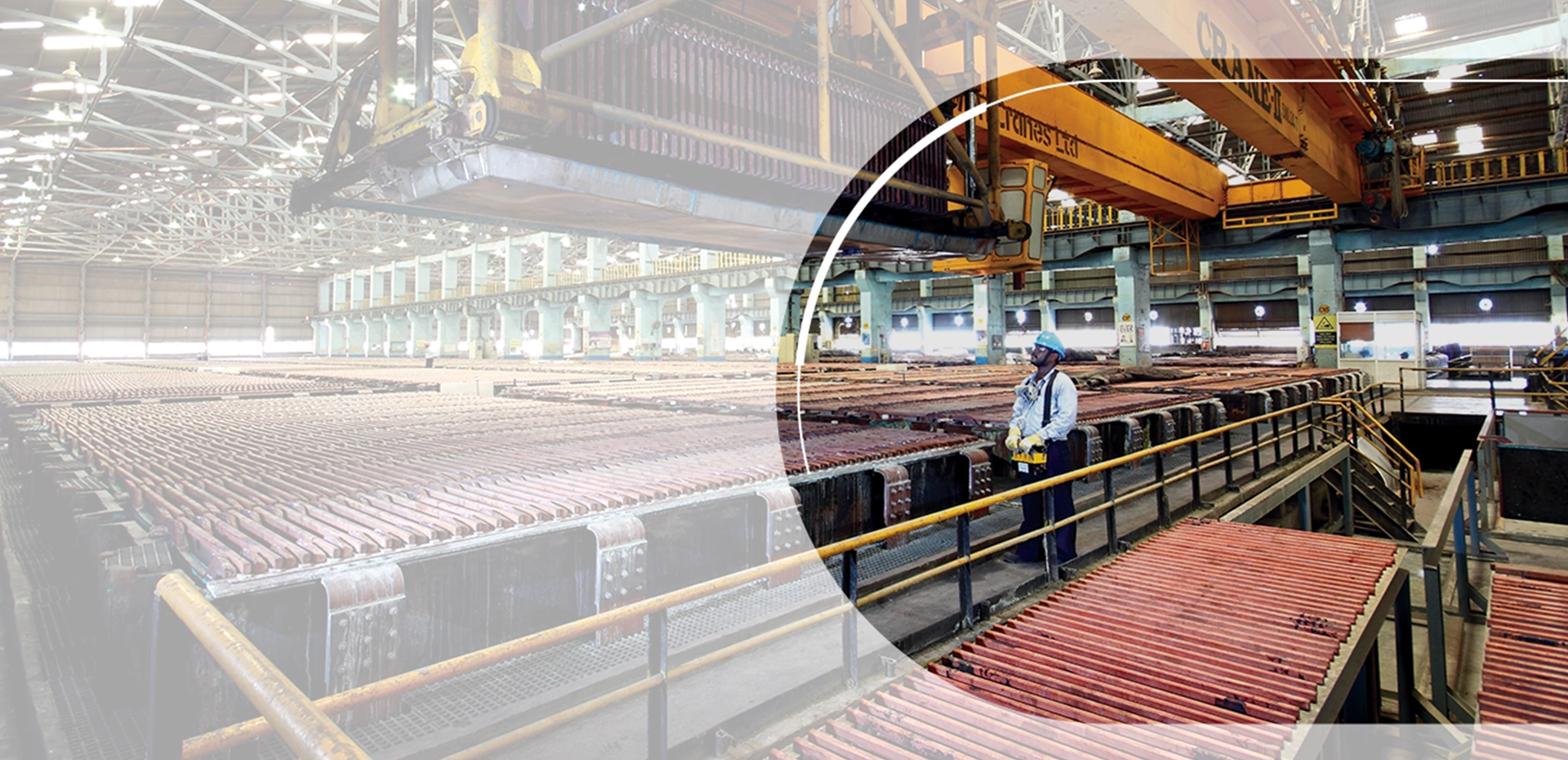
The year in brief
Silvassa operations continued to deliver 20% growth in sales volume on YoY basis and largely catering to India's domestic copper requirement.
The copper smelter plant at Tuticorin was under shutdown for the whole of FY 2023, while we continue to engage with the Government and relevant authorities to enable the restart of operations at Copper India.
148 kt
Cathode production from Silvassa
18% YOYOccupational Health & Safety
The lost time injury frequency rate (LTIFR) was 2.77 in FY 2023 (FY 2022: 0). Dupont Process Safety Management (PSM) Tool was launched for addressing the core elements of safety driven by sub committees under each PSM element. Received 4 Star Safety Rating from British Safety Council.
We conducted safety stand-downs to communicate the learnings from safety incidents and prevent future incidents. Our safety leadership regularly engages with the business partner site in-charges and their safety officers for their capability development and strengthening the culture of safety at our sites.
Environment
Aligned with the Vedanta’s vision to reach net zero emissions by 2050, Sterlite Copper has entered into a renewable energy sourcing agreement to produce Green Copper using 100% renewable energy & implemented AI & ML based Smart fuel optimisation for combined targeted GHG Emission reduction by 68,000 tCO2
Copper Mines of Tasmania continued in care and maintenance awaiting a decision on restart. Meanwhile, a small, dedicated team is maintaining the site and there were no significant safety or environmental incidents during the year. The site retained its ISO accreditation in safety, environment and quality management systems and the opportunity of a lull in production was used to review and further improve these systems.
Production performance
Operations
Copper production operations in Silvassa increased by 18% to 148 kt and have also seen growth of 20% in terms of sales volume and realised highest sales after closure of the Tuticorin unit and improved operational efficiencies, debottlenecking & capability building initiatives carried across the plant, the year also marked remarkable growth in free cash flow.
The Tamil Nadu Pollution Control Board (TNPCB) vide order, dated 9 April 2018, rejected the consent renewal application of Vedanta Limited for its copper smelter plant at Tuticorin. It directed Vedanta not to resume production operations without formal approval/consent (vide order dated 12 April 2018) and directed the closure of the plant and the disconnection of electricity (vide order dated 23 May 2018).
The Government of Tamil Nadu also issued an order dated 28 May 2018 directing the TNPCB to permanently close and seal the existing copper smelter at Tuticorin; this was followed by the TNPCB on 28 May 2018. Vedanta Limited filed a composite appeal before the National Green Tribunal (NGT) against all the above orders passed by the TNPCB and the Government of Tamil Nadu. In December 2018, NGT set aside the impugned orders and directed the TNPCB to renew the CTO. The order passed by the NGT was challenged by Tamil Nadu State Govt. in the Hon’ble Supreme Court.
The Company had filed a Writ Petition before the Madras High Court challenging the various orders passed against the Company in 2018 and 2013. On 18 August 2020, the Madras High Court delivered the judgement wherein it dismissed all the Writ Petitions filed by the Company. The Company has approached the Supreme Court and challenged the said High Court order by way of a Special Leave Petition (SLP) to Appeal and also filed an interim relief for care & maintenance as well as trial operation of the plant. The matter was then listed on 2 December 2020, before the Supreme Court. The Bench after having heard both the sides on the interim relief of trial operation of the Plant, concluded that at this stage the interim relief could not be allowed. Further, the matter was listed as item no. 22 on 10 April 2023 and was taken up and heard by the Supreme Court. The Bench allowed the activities as permitted in the letter of the Additional Chief Secretary to the district collector, namely:
I. Gypsum evacuation
II. Operation of Secured Landfill (SLF) leachate sump
pump
III. Bund rectification of SLF - 4
IV. Green-belt maintenance
Our copper mine in Australia has remained under extended care and maintenance since 2013. However, we continue to evaluate various options for its profitable restart, given the Government’s current favourable support and prices.
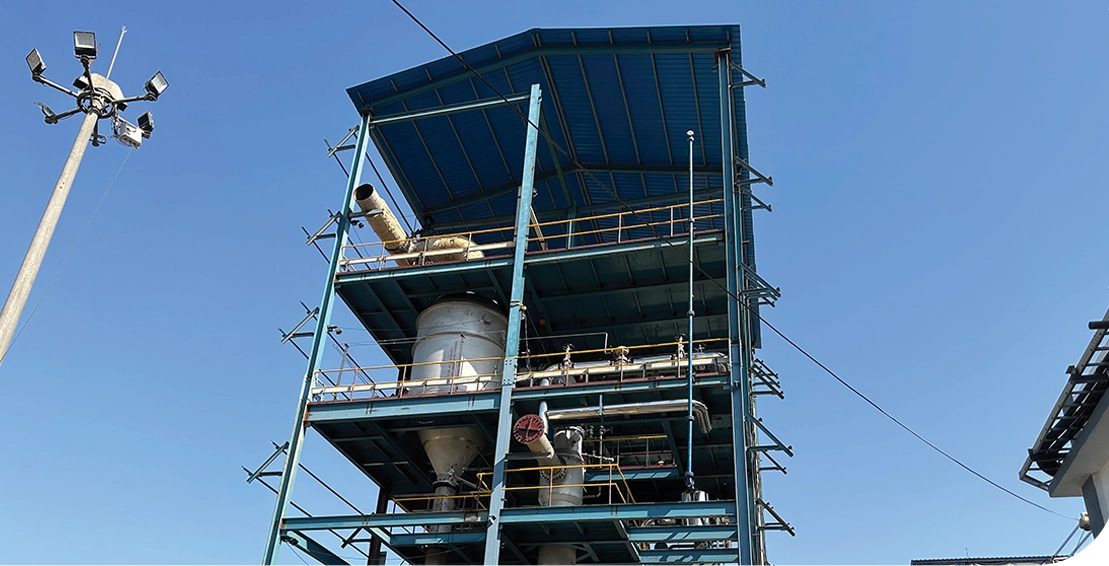
Prices
Average LME copper prices reduced by 12% compared with FY 2022 predominantly due to low demand in China owing to COVID restrictions.
Financial performance
During the year, revenue was ₹17,491 crore, an increase of 15% on the previous year’s revenue of ₹15,151 crore. The increase in revenue was mainly due to higher volume, favourable exchange rate partially offset by lower Copper LME prices. EBITDA improvement ₹111 crore mainly on account of improved operational efficiencies, higher volumes and increase in Sales Margin largely offset by a onetime charge against duty entitlement scripts of ₹64 crore.
Strategic priorities & outlook
Over the following year our, focus and priorities will be to:
Engage with the Government and relevant authorities to enable the restart of operations at Copper India;
Improving operating efficiencies, increasing Sales Margin, reducing our cost profile;
Upgrade technology & digitalisation to ensure high-quality products and services that sustain market leadership and surpass customer expectations; and
Continuous debottlenecking and upgrading our processing capacities for increased throughput.
PORT BUSINESS
Vizag General Cargo Berth (VGCB)
The volumes handled increased slightly by 1% YoY and the despatch volume increased by4% YoY. 3% of the total volumes handled represents Multi-cargo (i.e., other than coal) undersupplementary agreement signed with Visakhapatnam Port Authority (VPA).
Risk Management
 Know More
Know More
Vedanta has a well-defined risk management framework involving identification, evaluation, mitigation and monitoring of all risks to meet its objectives. This is enabled by a robust process that ensures all risks are identified at individual business level and across ongoing projects. The entire mechanism is led by structured risk management system and governance framework to ensure monitoring at multiple levels, and thus ensure operating controls are aligned to vision, mission and strategy. All the respective businesses of Vedanta undertake to review on a quarterly basis the risks relevant to it, the risk trend, control measures and actionable. Each business also develops its risk matrix and risk register, basis which the Group's principal risks are identified, and response mechanism formulated. Vedanta’s risks are broadly classified under sustainability risks, operational risks, compliance risks and financial risks.
Human Resources
 Know More
Know More
People are a key resource at Vedanta, and the Company strives to give them an enabling and fulfilling workplace. This is achieved through sustained actions around improving health and safety, driving diversity, equity and inclusion, and facilitating them equal learning and development opportunities. Transforming workplace is an important pillar in Vedanta’s ESG strategy, and the Company is undertaking definitive actions to achieve the various goals set under it.
Vedanta maintains a strong focus on attracting and retaining the best employees, which now includes finest minds from over 30 countries. The Company has a robust mechanism to hire talent from campuses and groom them. It also has multiple programs to build leadership, including ‘ACT-UP’ to identify and nurture talent and ‘Emerging Leaders Programme’ to identify and elevate individuals to CXO roles. During FY 2023, more than 500 employees were elevated through various programs. Vedanta is further using digital technologies to enhance learning experiences through initiatives like ‘Gurukul’ for knowledge-sharing and ‘Knolskape’ for simulation-based learning.
The Company has been actively promoting diversity and inclusivity with focus on improving representation of women, LGBTQ+ and other underprivileged or underrepresented communities. Programs like ‘V Lead’ and ‘V Engage’ are enabling this. The Company has also adopted a globally benchmarked methodology for rewarding and motivating its people and business partners, for long-term success. To notch-up safety, the Company launched HSE digital – incident management module in FY 2023 and also initiated roll-out of a critical risk management (CRM) module.
The Company’s robust people practices have resulted in several prestigious awards including Great Place to Work and Kincentric Best Employer 2022. As of 31 March 2023, the Company had 87,500+ in total workforce, with women representation increasing to 14% from 11% previous year.
Information Technology
 Know More
Know More
Technology implementation centred around digitalisation, automation, data analytics and Industry 4.0 technologies are major enablers of growth and future-readiness at Vedanta. The Company has made several investments towards this to enhance operational productivity, safety and sustainability. 100% of the Company’s workforce at digitally literate. Vedanta is currently implementing its digital transformation phase-2 project, aimed at becoming smarter and data-driven. Towards this, investments are being made in advanced technologies like advanced process control, digital twin, predictive analysis and asset performance monitoring among others. They are set to make the operations more reliable and efficient, with the use of data to analyse performance and take necessary actions.
